|

|
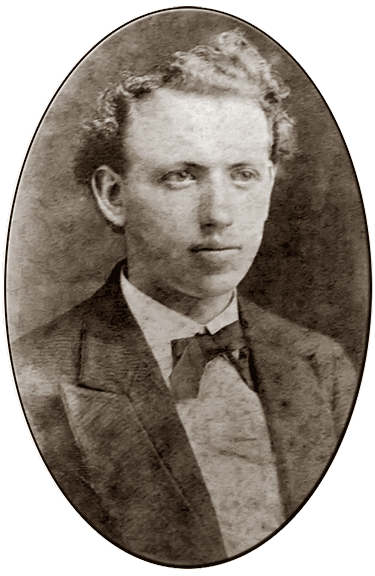
Robert Mugge at around 25 years old,
about the time he came to
Tampa. (1877)
Portrait from the family collection of his great-grandson,
Robert
E. Mugge.
|
The information used for this
feature comes primarily from "Robert Mugge, Pioneer Tampan, by Margaret Regener
Hunter,
Sunland Tribune, Journal of the Tampa Historical Society, Vol. 15, Nov.
1989. and from Robert E.Mugge. Margaret was a granddaughter of Robert Mugge.
Historical documents such as censuses and ship manifests, as well as
newspaper articles from the period are also used in this feature, some
of which provide facts differing from what Mrs. Hunter has written.
Robert E. Mugge is Robert Mugge's great-grandson. Historic
documents such as censuses, marriage licenses, etc., were obtained from
Family Search.
 obert Mugge literally helped
build Tampa. He was the first to put up street lights in the
neighborhood of his home in 1884, he owned a bottling plant near his
home, built an electric light plant, and ice manufacturing plant (he
bottled for Anheuser-Busch) on Central Ave., and opened the first legal
distillery in Florida at Cass St. and Central Ave. Mugge became a
successful beer distributor for Anheuser-Busch, and successful liquor
and wine wholesaler all over central Florida, as well as being a
watchmaker and saloon operator. He built several of the early brick
buildings in Tampa, including the 10-story Bay View hotel in downtown
Tampa, as well as bowling alleys and amusement parks. He even
authored a book, Practical Humanity, which
"has been selected by
scholars as being culturally important, and is part of the knowledge
base of civilization as we know it." obert Mugge literally helped
build Tampa. He was the first to put up street lights in the
neighborhood of his home in 1884, he owned a bottling plant near his
home, built an electric light plant, and ice manufacturing plant (he
bottled for Anheuser-Busch) on Central Ave., and opened the first legal
distillery in Florida at Cass St. and Central Ave. Mugge became a
successful beer distributor for Anheuser-Busch, and successful liquor
and wine wholesaler all over central Florida, as well as being a
watchmaker and saloon operator. He built several of the early brick
buildings in Tampa, including the 10-story Bay View hotel in downtown
Tampa, as well as bowling alleys and amusement parks. He even
authored a book, Practical Humanity, which
"has been selected by
scholars as being culturally important, and is part of the knowledge
base of civilization as we know it."
When he died in Tampa
in 1915 at age 63, he was still working 18-hour days. His funeral was reported to be one of the
largest ever held in Tampa and was held from the family home on a Sunday
morning.
|
|
Robert Mugge devoted his life to the building of Tampa which he
loved so well. He would invest every dollar he made in Tampa, back into
the Tampa economy, thereby
giving employment to thousands of breadwinners. He was a law-abiding
citizen and would not tolerate any violation of any kind by his
employees.
He, and his estate in later years, paid well over $1,000,000 in
City and County taxes in addition to a large number of occupational
licenses.
Upon his death, The Tampa Tribune published this eulogy,
which begins:
|
Robert Mugge's great-grandson,
Robert E. Mugge, is an American documentary film maker. He has
focused primarily on films about music and musicians, but some of
his earliest films were not music focused and he is now continuing
to branch out as his interests and work evolve. |
A GREAT MAN GONE
Robert Mugge was an old citizen of Tampa but not an old man, and
was a remarkable character. A man of intelligence and business
acumen. One of the most enterprising of our citizens. A man of
energy; he fought the battles for fortune unsurpassed though
afflicted physically. This was a "great" man, though few people
knew it, nor did he..
The entire eulogy can be read towards the end of this feature.
|
|
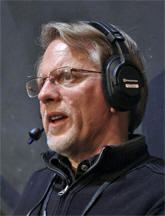
R. E. Mugge
has recently come into possession of many family records,
including candid photos of his great-grandfather, and memoirs the
senior Mugge typed up for the benefit of Robert E. Mugge's
parents. He plans to create a documentary "portrait" of his
great-grandfather when has enough material.
Check out Robert E.
Mugge's website:
www.robertmugge.com
and stay
tuned to this feature for updates. |
|
 obert Mugge was
born Jan. 5, 1852 in Lauterberg, Harz, Germany, the son of
Louis Mugge and Louisa Manzel1.
He came to America on his own in at age 17, travelling in steerage
class on the steamship Iowa, mastered by David Houston. Though the
ship's manifest shows it departing from Glasgow, Scotland,
German emigrants in this period almost always originated from the
port of Bremen, Ger. to Glasgow, Scotland or Southampton, England, and then to New York on the same
ship, or via a transfer.
Robert likely originally departed from the Port of Bremen.
He arrived at the Port
of New York on Sept. 19, 1870. obert Mugge was
born Jan. 5, 1852 in Lauterberg, Harz, Germany, the son of
Louis Mugge and Louisa Manzel1.
He came to America on his own in at age 17, travelling in steerage
class on the steamship Iowa, mastered by David Houston. Though the
ship's manifest shows it departing from Glasgow, Scotland,
German emigrants in this period almost always originated from the
port of Bremen, Ger. to Glasgow, Scotland or Southampton, England, and then to New York on the same
ship, or via a transfer.
Robert likely originally departed from the Port of Bremen.
He arrived at the Port
of New York on Sept. 19, 1870.
____________________________
1According
to his death certificate.
SS Iowa passenger manifest edited to conserve space. |
|
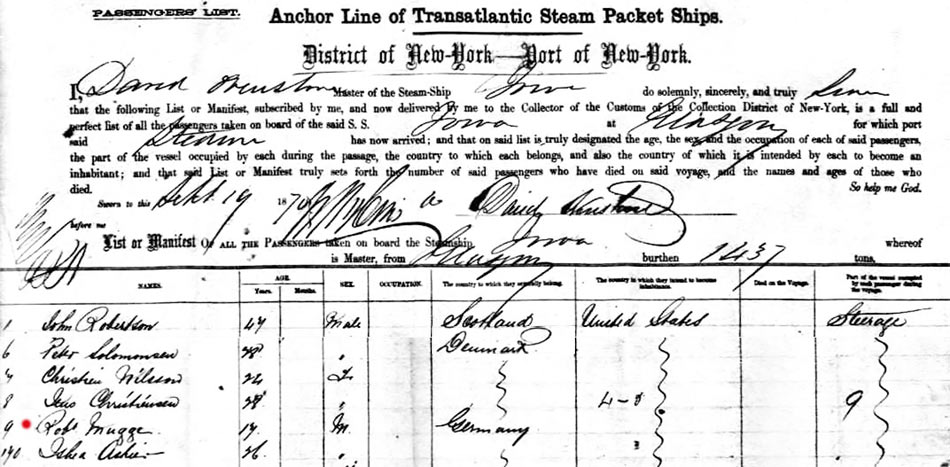
|
|
"New
York Passenger Lists, 1820-1891," database with images, FamilySearch
, 334 - 30 Aug 1870-26 Sep 1870 > image 294 of 464; citing NARA
microfilm publication M237 (Washington D.C.: National Archives and
Records Administration, n.d.). |
| |
|
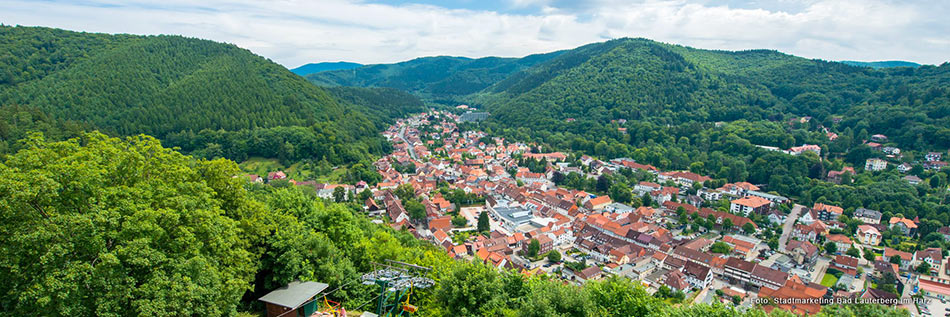 |
|
Modern day
Bad Lauterberg
Photo from
Wander Kompass |
|
|
|
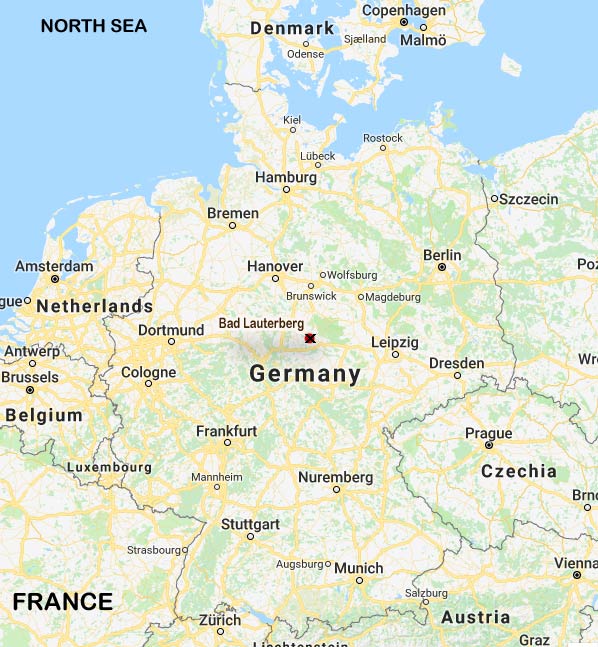 |
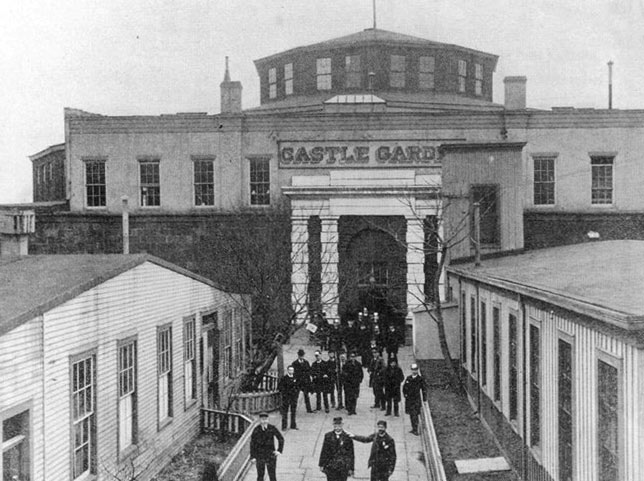 |
|
Modern day
map showing location of Bad Lauterberg.
Place your cursor on
the photo to see it during the time Robert Mugge was born.
Maps from Wikipedia.
Before Germany was unified into a politically and administratively
integrated nation in Jan., 1871, it existed as approximately
39 separate states, or "duchies" in the mid-1800s, each ruled by its
own Duke. The largest flow of German immigration to America
occurred between 1820 and World War I, during which time nearly
six million Germans immigrated to the United States. From 1840 to
1880, they were the largest group of immigrants to the U.S. Most
of them came because of civil unrest, severe unemployment,
deplorable conditions, and almost inconceivable hardships at home.
By 1890, an
estimated 2.8 million German-born immigrants lived in the United
States. A majority of the German-born living in the United States
were located in the "German triangle," whose three points were
Cincinnati, Milwaukee, and St. Louis.
Shortly after his arrival in
New York, blonde, curly-haired 17-year-old Robert Mugge
looked up some relatives in Terre Haute, Indiana and soon settled there.
He was soon followed by his entire family; his parents, a brother Louis;
a sister Bertha, and her husband, Wilhelm Mahn.2 |
Photo from National Park Service Castle Clinton National Monument,
New York
Robert would not have seen
the Statue of Liberty or Ellis Island upon entering New York Harbor; he arrived before these
landmarks were in existence. Instead, he would have undergone
immigrant processing at Castle Garden (sometimes called by its earlier
name, Castle Clinton), an old fort on the lower tip of Manhattan,
which was
designated as an immigrant station under the supervision of the State
of New York in 1855. When a new federal law was passed in 1882, Castle
Garden continued to operate under contract to the United States
government. By 1890, however, the facilities at Castle Garden had long
since proved to be inadequate for the ever-increasing number of
immigrant arrivals.
Read more about immigrant processing at Castle
Island:
|
|
__________________________________
2In Robert Mugge, Pioneer Tampan, by Margaret Regener
Hunter, William is misidentified as "Louis Mann." See below
passenger manifest of the SS Hansa and 1880 Census of Tampa for evidence which shows he was Wilhelm
(William) Mahn. |
| |
|
Passenger Manifest of the SS Hansa from Bremen to New York, 1871

Wilhelm and Bertha Mahn
(Robert Mugge's sister) sailed on the SS Hansa from the port of
Bremen,
arriving at the Port of New York on Sept. 17, 1871. Wilhelm was
28; his occupation was Tailor. Bertha was 25. Both of
their ages are in agreement with their ages on the 1880 and 1885
censuses. |
SS Hansa
Info
& image courtesy of Immigrant Ship Information
Launched August 1861
Went missing July 1883
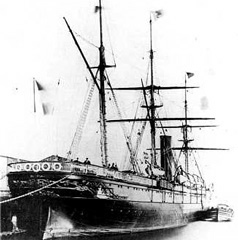 This
steamship was built by Card & Co. of Greenock, Scotland for
Norddeutscher Lloyd (North German Lloyd). She weighed 2,992 gross
tons, had a length of 328 feet and a beam of 42 feet, one funnel,
three masts, and a single screw. Her service speed was 11 knots.
There was accommodation for 75 first-class, 105 second-class, and
480 third-class (steerage) passengers. She had a crew of 102. This
steamship was built by Card & Co. of Greenock, Scotland for
Norddeutscher Lloyd (North German Lloyd). She weighed 2,992 gross
tons, had a length of 328 feet and a beam of 42 feet, one funnel,
three masts, and a single screw. Her service speed was 11 knots.
There was accommodation for 75 first-class, 105 second-class, and
480 third-class (steerage) passengers. She had a crew of 102.
Launched on 23 August 1861, she began her maiden voyage from
Bremen to Southampton and New York on 24 November 1861. She made
her last voyage for this company on 12 November 1878. In 1881, she
was chartered to Adamson & Ronaldson, and given compound engines.
Between May 1881 and March 1882, she made six round trip voyages
from London to Boston.
In 1883 she was sold to the White Cross Line, Antwerp, who renamed
her Ludwig.
She sailed from Antwerp for Montreal on 2 July 1883 and went
missing after making contact on 3 July with Prawle Point, 20 miles
southeast of Plymouth. Twenty-seven passengers, 43 crew, and 433
head of cattle were lost.
|
|
|
|
1860
census, Mt. Vernon, Indiana
Possible family Robert Mugge joined in Terre Haute, Ind.
 |
|
George Mugge and his family may have been the relatives that
Robert joined in Terre Haute in 1870. George and his family
have not been located on the 1870 census yet to see if they were
in Terre Haute by that time, but in 1860 he and his family were
about 140 miles south of Terre Haute in Mt. Vernon, Ind. George was from Hanover and
worked as a distiller; an occupation which Robert would later take
up. George may have taught Robert the basics of brewing beer and
distilling liquor in the approximate 5 years Robert was there. |
| |
|
Robert Mugge's first
marriage
Robert Mugge was
a jeweler by trade. In 1875 in Vigo County, Ind., he married Alice McCullough, a
milliner. They soon had three sons.
Robert's
marriage license for first marriage - Alice McCullough, in Vigo
County, Indiana. Notice the umlaut over the "U"-- Mügge.
This is pronounced with a long "u" as in "uniform." Often, the
umlaut is removed and substituted with "ue" as in Müller = Mueller.
The Mugge
descendants today pronounce it like the weather in Florida during
summertime--muggy.
|
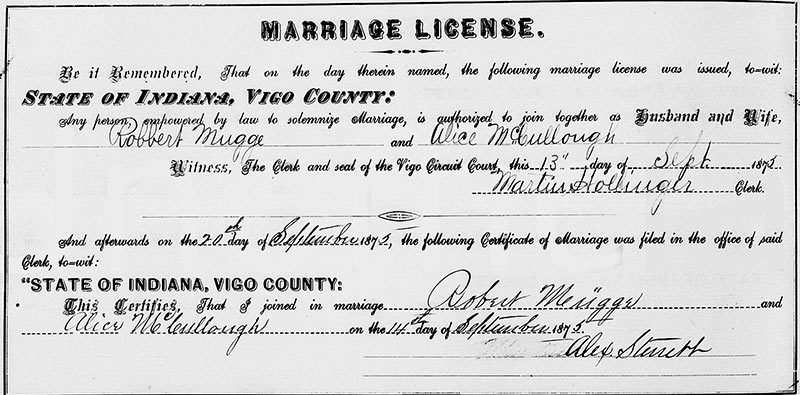
Marriage License of Robert Mugge and Alice McCullough |
1870 U.S. census of Ward 5,
Terre Haute, Ind.
|
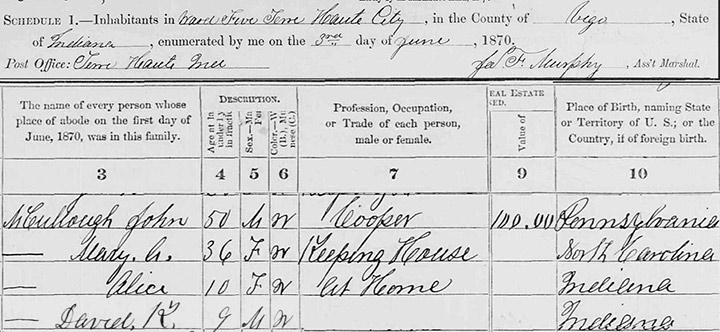 |
|
The 1870 census of Terre Haute, Indiana shows Alice's father
was 50 and her mother was 36, born in North Carolina. Alice
was 10 and her brother, David K. was 9, both born in Indiana. |
According to the 1870 census of
Ward 5, Terre Haute, Ind., Alice was the daughter of John & Mary
McCullough. John was a cooper (barrel or cask maker or repairer) from Pennsylvania.
If Alice's age on this census
is correct (10 years old), she was only 15 or 16 when she married Robert
in 1875.
After the death of his father (who is buried in Terre Haute)
Robert Mugge, an asthma sufferer, decided to go south to Cuba.3
He and his brother-in-law probably boarded a schooner in Mobile, which was to take
them to Cuba via Tampa. (He probably sailed on a schooner run by James
McKay, who had a shipping line between Mobile and Tampa in those years.)
The ship remained in Tampa for a few
days to unload its cargo, giving Mugge enough time to see the town.
He liked Tampa well enough to decide to settle here4
and so he did in 18775.
Robert and William's wives in Indiana followed after about 3 years,
probably to allow their husbands to establish their home site and
businesses.6
Robert was a watchmaker, his brother-in-law was a tailor,
so they decided to go into business together as a sideline and opened
a grocery and general merchandise store. They bought a quarter of a
block of land located at the northwest corner of the intersection of Marion and Jackson
streets.7
According to records in the
courthouse, they paid $50 for it. There they built
a two-story wooden building.8 The store faced Marion Street with rooms
for rent on the second floor. The families lived in another two-story
building in the rear facing Jackson Street.
___________________
3According to Margaret
Regener Hunter in Robert Mugge, Pioneer Tampan.
4Margaret Regener Hunter says
Robert's family came along with him on the trip to Cuba with a layover
in Tampa. The 1880 census shows both men living by themselves in
Tampa. It is not known why Mrs. Hunter believes they came to Tampa by 1875.
5Mrs. Hunter has them in Tampa by 1875,
but Robert's great-grandson, Robert E. Mugge, has come into possession
of the first edition of his great-grandfather's memoirs, which is the
source of the 1877 date.
6Mrs. Hunter says "His
folks in Indiana followed shortly thereafter," but no other Mugge family
member besides Robert and his brother-in-law is listed on the census
of 1880 in Tampa, not even his wife or sons.
7Mrs. Hunter states the
property was on the northeast corner, which is incorrect. It was the
northwest corner of the intersection of Jackson and Marion, or the
southeast corner of the BLOCK bound by Jackson, Marion, Monroe (Florida
Ave.) and Lafayette (Kennedy Blvd.) See Sanborn maps below.
8Mrs.
Hunter
also says Robert bought the lot. However, on the 1880 census,
William is the head of house and Robert is listed as a boarder (column 6
"Relationship to head of house), an unusual arrangement for Robert to be
the tenant if he paid entirely for the property and construction of the
house. The term "Boarder" should be listed in column 6 if there was
no family relationship to the head of house. It should have read
"brother-in-law".)
1880 Census, Hillsborough Co.,
Town of Tampa
|
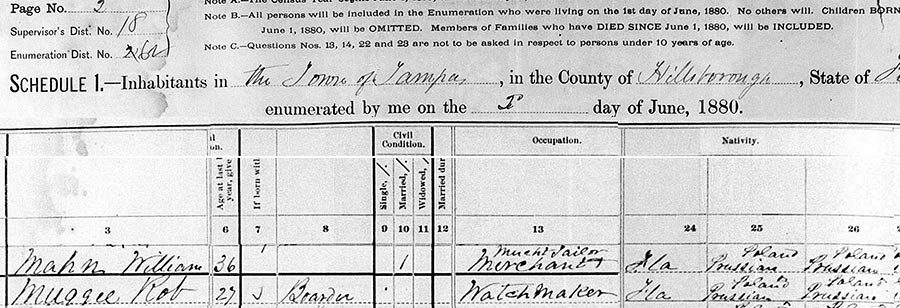 |
|
Robert's brother-in-law was William Mahn, not Louis Mann.
Mahn was 36, Robert 27. William and Robert were each married, but no mark is
made for Robert. Robert was married in Sept. 1875, but it appears
that their wives remained behind until the at least, June 1,
1880, probably
waiting until the men had their living accommodations and
businesses established. The interesting fact shown here is
that it was Mugge who was the boarder, and Mahn the head of
the residence. If Mugge bought this property and built this
2-story dwelling, why would he be listed as a boarder with Mahn
the head? Mahn was a -- tailor/merchant, Mugge was
a watch maker. Both are listed as being born in Florida,
which is incorrect. Their parents birth places were listed as
Prussia/Poland.
|
|
In 1876 Robert
Mugge took out naturalization papers and became an American
citizen9.
In February 1879,
his wife Alice and their three sons died of the yellow fever
epidemic and were buried in Oaklawn Cemetery9.
|
Last Name |
First Name |
Cemetery |
Section |
|
|
MUGGE |
ALICE M. |
OAKLAWN |
5 |
|
|
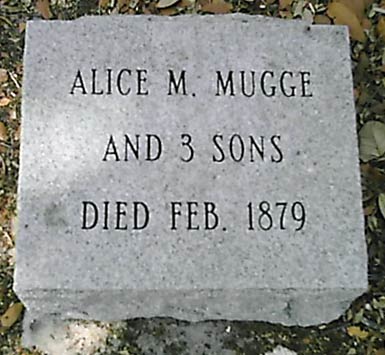
Photo by Janet McCrary at Find A Grave |
Robert
Mugge remarries
|
A few years after
Alice's passing, Robert Mugge wished to remarry and corresponded
with Caroline Rautenstrauch who lived in Goslar, Hanover, Germany.
She was born in Braunschweig (Brunswick) Germany and came to
America by boat, landing at Fernandina, Florida, where she and
Robert Mugge were married Oct. 12, 1882. Mugge had chartered a
schooner owned by Captain George Hansen of Tampa. The schooner
traveled around the state of Florida to arrive in Fernandina. They
returned to Tampa by the same schooner9.
_________________________9Robert
Mugge, Pioneer Tampan, by Margaret Regener Hunter
|
1885 State Census of Florida
In addition to the Federal
censuses taken every 10 years on the first year of a new decade, the
State of Florida collected three state censuses: 1885, 1925 and 1935.
On the 1885 census the
Mugge family was living nearby to merchant & future
Tampa mayor Herman Glogowski,
and former mayor and merchant,
Josiah Ferris.
1885 Florida State census
|
 |
|
This census
shows Robert was 32, Caroline
was 24, and their daughter Louisa was 1.
Robert's
brother-in-law has passed away; living in their home was
Robert's widowed sister, Bertha Mahn, age 40.
Also in
their home was Karl Pinkert, age 23, a clerk by occupation. His
relationship shows "inmate," which besides a prisoner (which obviously
was not) could mean a hospitalized person.
However,
reviewing what the law dictionaries tell us that the word "Inmate"
means: a “person who lodges or dwells in the same house with
another, occupying different rooms, but using the same door for
passing in and out of the house” or “one who dwells in a part of
another’s house, the latter dwelling, at the same time, in the
said house.”
That’s more
the way it was used in the census: lots of places where people
were perfectly free to come and go — like hotels and boarding
houses and hospitals and convents — would have the residents
listed as inmates. From
The Legal Genealogist |
|
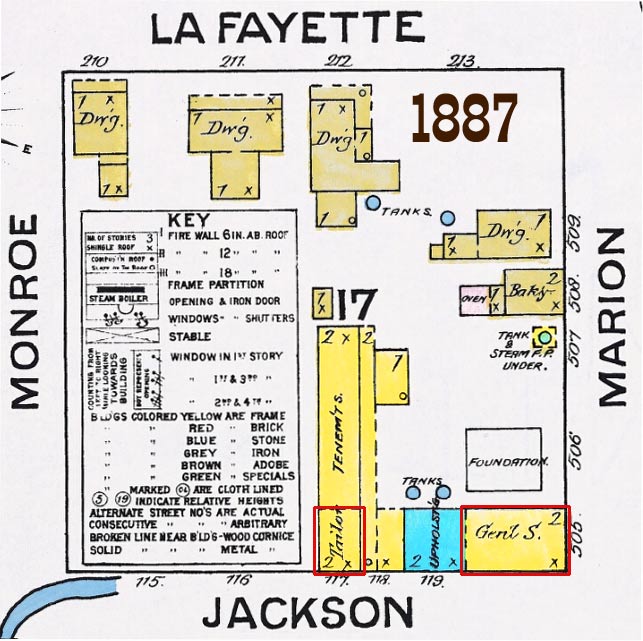 |
The
1887 Sanborn map at left is from the University of Florida
Library digital map collection. It shows Monroe Ave. which
soon was renamed "Florida Ave." The Mahn/Mugge property was located
on the southeast quarter of the block.
Unfortunately, this block is
obscured on the 1884 Sanborn map. It only shows this notation:

"4 frame
dwellings, 1 barn and 1 General Store in this block.
Notice their general store on the corner and
Wilhelm's tailor shop
in the middle of the Jackson St. block. Above the general
store is a foundation; indication that something was going to be
built there.
|
| |
|
|
The
1889 Sanborn map
at right is from the University of Florida Library digital
map collection. It shows Monroe Ave. was renamed "Florida Ave."
The foundation on the 1887
map is now an ice house and a new structure has been added just
north of it--a 2-story mineral water factory.
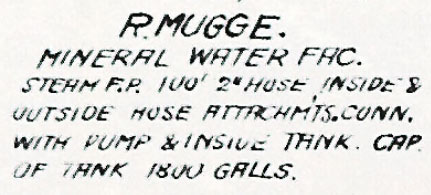
The tenements have become a
dwelling and the space formerly occupied by the general store,
upholsterer and tailor is mostly vacant. Preparations were
apparently being made to convert the whole building into living
space.
Notice Florida Avenue in
place of Monroe.
|
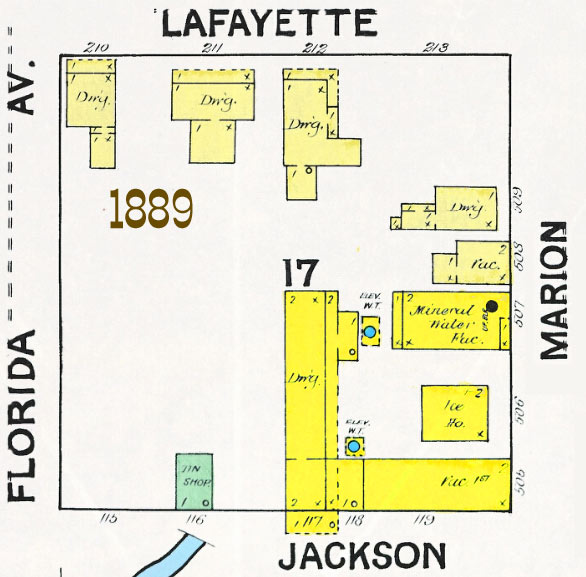
|
|
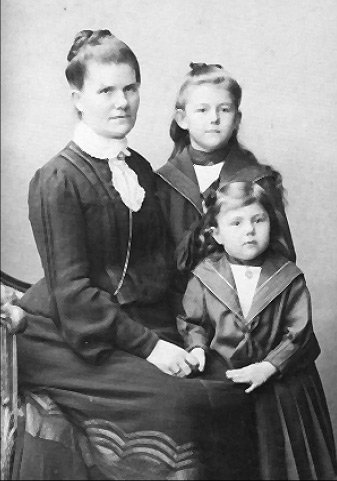 |
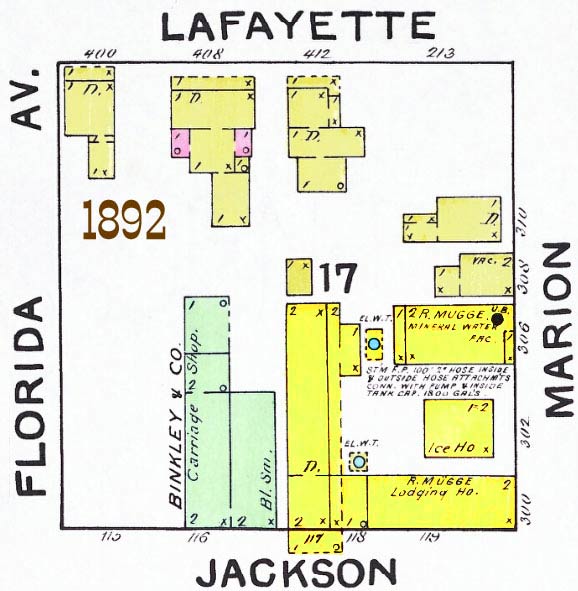 |
|
Mrs. Caroline Mugge and
daughters Louise, 7, and Frances, 2. Taken in Germany in 1890. -Photo by
Georg Meyer, in Braunschweig, GER.
Photo from the Sunland Tribune, Journal of
the Tampa Historical Society, Vol. 15, Nov. 1989. "Robert Mugge, Pioneer
Tampan, by Margaret Regener Hunter. |
The
1892 Sanborn map
above is from the University of Florida Library digital
map collection. It shows Binkley & Co. carriage shop
has situated just west of the Mugge property. The
structure at the lower right corner which was vacant in
1889 now is Mugge's lodging house. |
The
portrait of Caroline, Louisa and Frances was taken when the
Mugges went back to Lauterberg and had Frances christened on
June 6, 1890. Frances was born Frances Bertha
Mugge in Tampa on Sept. 9, 188810.
August Bremer Mugge was born Sept. 10, 1890 in Tampa, so
Caroline was about 6 months in expecting August when the
portrait was taken.
________________________
10Florida
Births and Christenings, 1880-1935, database, FamilySearch,
Robert Mugge in entry for Frances Bertha Mugge Reiner, 09 Sep
1888; citing Tampa, Hillsborough, Florida, reference File # 5-301;
FHL microfilm 978,720. |
|
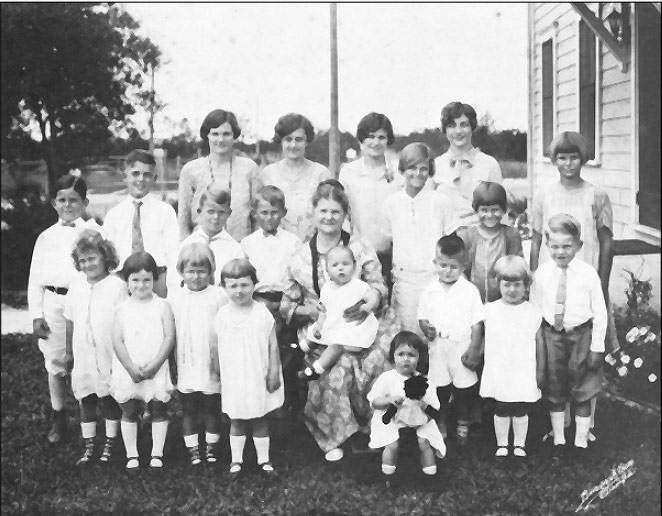
THE MUGGE FAMILY
PORTRAIT
Mrs. Caroline Mugge, widow of Tampa pioneer Robert Mugge, taken on her
65th birthday anniversary, June 16, 1927, at the Lake Magdalene
home of Herman and Louise (Mugge) Regener and family. Back row,
left to right: Anna, Hermina, Frances Regener, and Marie Mugge.
Middle row: Gene Mugge, Jr., Otto and Ernest Reiner, Herman
Regener, Jr., Grandmother Mugge holding Gretchen Petri, Margaret,
Marnel and Lena Regener. Front row: Ruth Regener, Carmela Mugge,
Carolyn Regener, Martha Petri, Pat Mugge (seated), Walter Reiner,
Dora and Bob (Robert) Mugge.
Burgert Bros. Photo from the Sunland Tribune, Journal of the Tampa
Historical Society, Vol. 15, Nov. 1989. "Robert Mugge, Pioneer
Tampan, by Margaret Regener Hunter. |
Together, Robert and Caroline started a large family--nine children--including two who died
young. Tom died in September 1898 from typhoid fever and Alice in
1902 a few days after her birth. Some of the children were named
after presidents and Nellie was named after a daughter of Adolphus Busch
and his wife, Lilly (Anheuser) Busch of
Anheuser-Busch Company fame.10
Mr. and Mrs. Busch spent their
winters at the Tampa Bay Hotel and the two families were close
friends.
10Margaret Hunter
erroneously states that Nellie was Adolphus Busch's wife.
Adolphus's wife was Eliz. Lilly Anheuser, daughter of Eberhard
Anheuser.
|
|
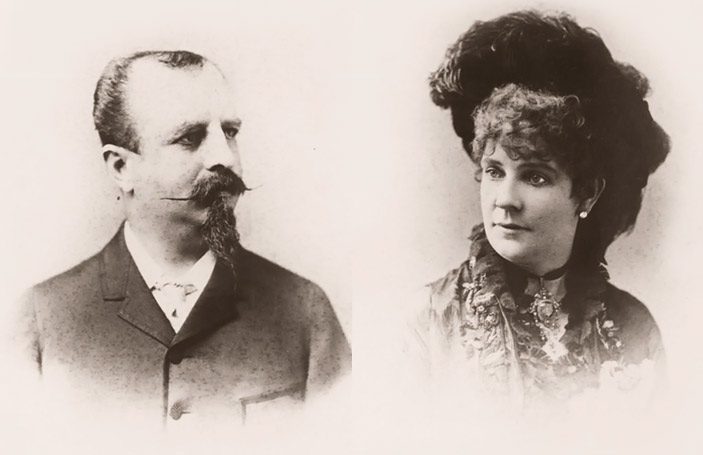
Adolphus Busch & wife Lilly
Anheuser Busch
circa 1870
Portraits courtesy of
Missouri Historical Society |
Their nine children
were:
|
|
Name (married name) |
Born |
Married |
Died |
|
1 |
Louisa Melanie Mugge (Regener) |
1883
|
|
1930 |
|
2 |
Eugene George
Mugge |
1885 |
|
1939 |
|
3 |
Frances Bertha Mugge
(Reiner) |
1888 |
|
1971 |
|
4 |
August Bremer Mugge |
1890 |
|
1979 |
|
5 |
Melanie Wilhelmina Mugge |
1892 |
|
1934 |
|
6 |
Thomas Paine Mugge |
1895 |
|
1898 |
|
7 |
Martha Washington Mugge |
1897 |
|
1978 |
|
8 |
Nellie Busch Mugge (Petri) |
1899 |
|
1982 |
|
9 |
Alice Roosevelt Mugge |
1902 |
|
1902 |
Robert Mugge 1900 U.S. Census in Tampa -
302 Marion St.
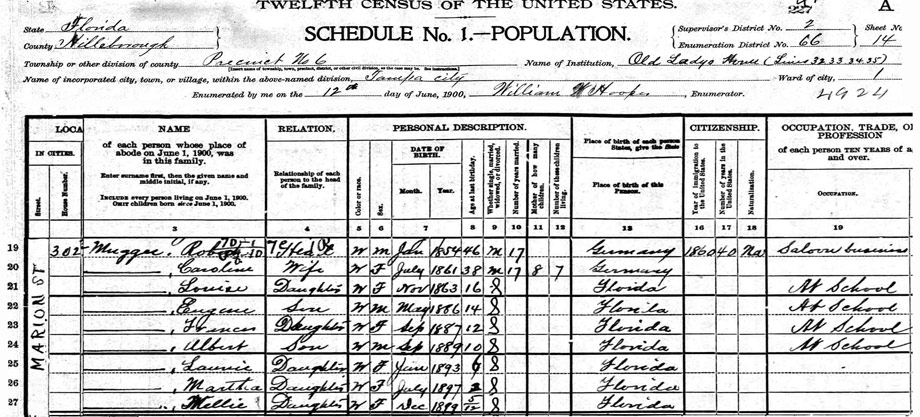
The 1900 US Census shows Robert Mugge
living at 302 Marion St. in Tampa. It shows he was born in
Jan. of 1854 in Germany and was age 46. It shows that he immigrated in 1860, had
been in the US for 40 years and was a naturalized citizen, but this
information appears to be inaccurate, possibly given by Caroline who was
his 2nd wife. Ship passenger records of the SS Iowa show he
arrived in 1870. See a
portion of the list. He was
married to Caroline for 17 years who was the mother of 8 children, with
7 living at the time. Robert's business was "Saloon business."
Robert & Caroline's children were listed as Louise, Eugene, Frances,
Albert (August), Lannie (Melanie), Martha and Willie (William, age 5 mos.).
In the ensuing years, Robert Mugge
literally helped build Tampa. He was the first to put up street lights
in the neighborhood of his home in 1884, he owned a bottling plant near
his home, built an electric light plant, and ice manufacturing plant (he
bottled for Anheuser-Busch) on Central Ave., and opened the first legal
distillery in Florida at Cass St. and Central Ave. Mugge became a
successful beer distributor for Anheuser-Busch, and successful liquor
and wine wholesaler, as well as being a watchmaker and saloon operator.
|
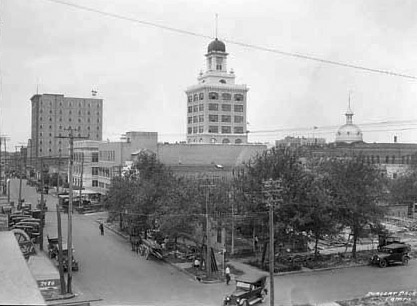 |
At the time he came to
Tampa (1877), the only equipment firemen had consisted of twenty
buckets, two scaling ladders and some axes. Needless to say,
more than a little difficulty was encountered in batting
serious conflagrations. This was clearly shown May 8, 1886,
when all the buildings except the First National Bank were
wiped out in the block bounded by Franklin, Whiting, Tampa
and Washington. Included among the structures destroyed were
two buildings owned by W.B. Henderson, a new store of
Friebele & Boaz, the Baldwin House, the furniture store of
A. Glass & Bros., and the warehouse of Miller & Henderson.
The loss was estimated at $30,000.
Immediately after
this 1886 fire the town council decided it might be wise to
invest in a fire engine so a $600 "hand pumper" was ordered,
donated to the city by Robert Mugge.
Known as the Mugge pump
it was equipped with 350 feet of two-inch hose and was dragged
through the city streets by hand. It came July 30 along with the
350 feet of two-inch hose and a hose reel.
|
|
The Mugge
property after demolition in 1922.
The Bay View Hotel can be seen at the left side of the
photo.
Burgert Bros. photo from the Tampa Hillsborough County Public
Library digital collection. |
|
Almost everyone in
town turned out the next day to see the engine tested. The
hose was run down to the river and six of the strongest
firemen began laboring on the pumps. The results were
splendid--a stream of water was thrown clear over the top of
John T. Lesley's two-story building at Franklin and
Washington. To make effective use of
the new equipment, the Tampa Fire Company was organized August 30,
1886, with A. C. Wuerpel as president, Robert Mugge as secretary,
and Herman Glogowski as treasurer. Other members were G. B.
Sparkman, Odet Grillon, H. Heargeist, C . Pinkert, John R. Jones,
Leon Dartize, Charles G. Lundgren, J.O. Nelson, Vinsente deLeo,
and Ernest Geistenberger. These men, and the members of the
Hook & Ladder Company, served without pay.
http://www.tampasbravest.com/History___Highlights.php |
In 1900 Tampa had three
well-established wholesale groceries--J. Q. Brantley, I. S.
Giddens & Co., and the Tampa Wholesale Grocery Company, operated
by T . P. Lightfoot. Crenshaw Brothers and J. P. Hardee & Company
were wholesale dealers in fruits and vegetables, Phillips & Fuller
wholesaled building supplies. The Bentley-Gray Dry Goods Company
was widely recognized as one of the leading wholesale dry goods
firms of the state. Nick Kokin had built up a thriving business in
tropical fruits. Both the Tampa Harness &: Wagon Company, operated
by Thomas N. Henderson, and E. D. Hobbs & Company were wholesaling
bicycles as well as wagons, buggies and harness. Robert Mugge sold
beer and liquor all over South Florida and his business was
flourishing.
Louisa Melanie Mugge (Regener)
at age 16, around 1899.
Photo by MORAST, Tampa, from
Robert Mugge, Pioneer Tampan, by Margaret Regener
Hunter,
Sunland Tribune, Journal of the Tampa Historical Society, Vol. 15, Nov.
1989.
|
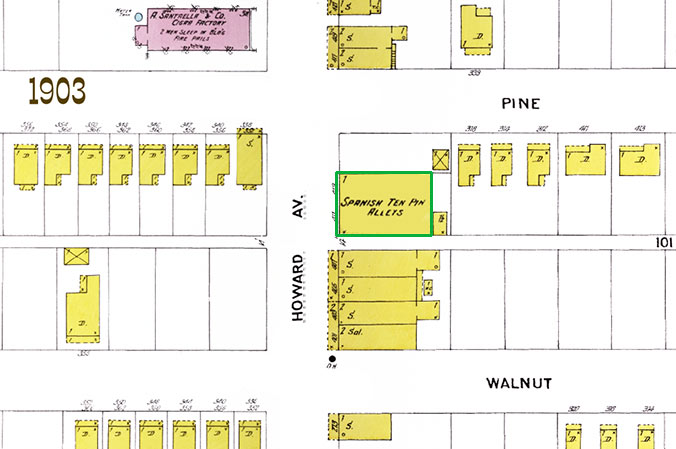 |
|
**The newspaper
article which was the source of the info on the fire has
their cigar factories flip-flopped. Santaella was on
Howard, caddy corner to
Mugge's "Spanish Ten Pin Alleys" as seen above.
Leopold Powell was on Armenia. |
WEST TAMPA FIRE
On April 4, 1904, Robert Mugge's
West Tampa saloon caught on fire. The building, located on Pine Street near
Howard Avenue, was quickly devoured by the hungry flames, and before
volunteer firemen arrived with their hoses reels, the blaze had spread
to nearby homes and businesses. Authorities say the fire could have been
contained to the initial area, but high winds from the northeast fanned
the flames southwestward across Howard Avenue and west down to
Armenia Avenue, consuming everything in their path,
including the
A.
Santaella cigar factory at 1906 N. Armenia.** The Leopold Powell
Company on the northeast corner was spared due to the wind direction,
but over 100 homes and 5 factories to the southwest were destroyed.
All were constructed of highly flammable wood except for one factory,
which was of brick. The high winds, lack of available water
sources, and West Tampa's inadequate fire fighting capability were all
blamed for the extensive damage. Losses were estimated to be
$200,000. Read about this fire in detail.
Visit "Tampa's
Bravest", a website dedicated to the history of Tampa's firefighters
In 1905, Mugge took on the pro-temperance movement and prohibitionists
in the town of Kissimmee. Mugge said he "does not intend to take a
dollar away from Kissimmee, but will spend two dollars for every one--of
his profits--in buying and improving property and otherwise contributing
to the up-building of the town."
|
 Newspaper
images from the University of Florida Digital Newspaper
Library. Newspaper
images from the University of Florida Digital Newspaper
Library. |
|
March 10, 1905
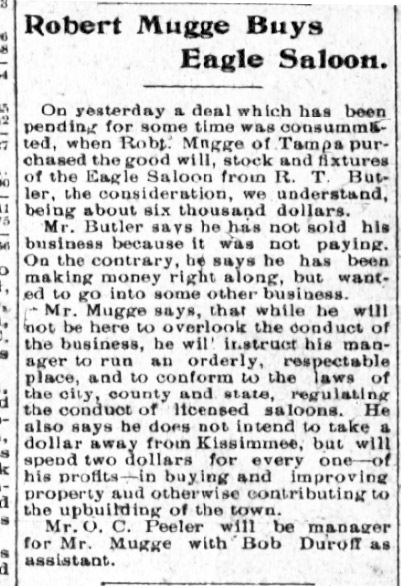 |
This
article has been edited by removing items on the agenda not
relating to Mugge to conserve space.
Mugge's
application is examined by the city council
and ordered to be published. |
|
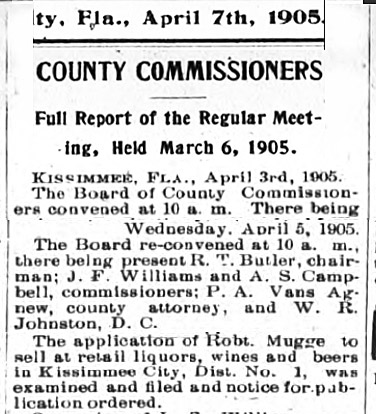
Entire article online |
|
Newspaper images from the University of Florida Digital
Newspaper Library. |
|
A crowd
gathered at the courthouse on May 2nd, 1905, with ladies and
a Methodist pastor, to protest approval of Mugge's permit.
They objected on grounds that Mugge was not a law-abiding
citizen of good character and they produced an affidavit
signed by Tampa's clerk of police stating that Mugge had
been recently convicted and fined for violating an ordinance
of the city. They also produced a Tampa Tribune
article relating to the violation. This was followed
by an eloquent speech from the Methodist pastor representing
the ladies asking that Mugge's permit not be granted. Board
chairman R.T. Butler asked to be excused from acting in the
matter due to his recent sale of is saloon to Mugee.
Mugge's
attorney produced an affidavit signed by Tampa's current
mayor Salomonson, former Tampa mayor and Florida senator
John T. Lesley, and Judge W.B. Henderson, all attesting to
Mugge's good character and law-abiding citizenship.
Following a "forcible" argument by Mugge's attorney, the
board of county commissioners granted Mugge's permit.
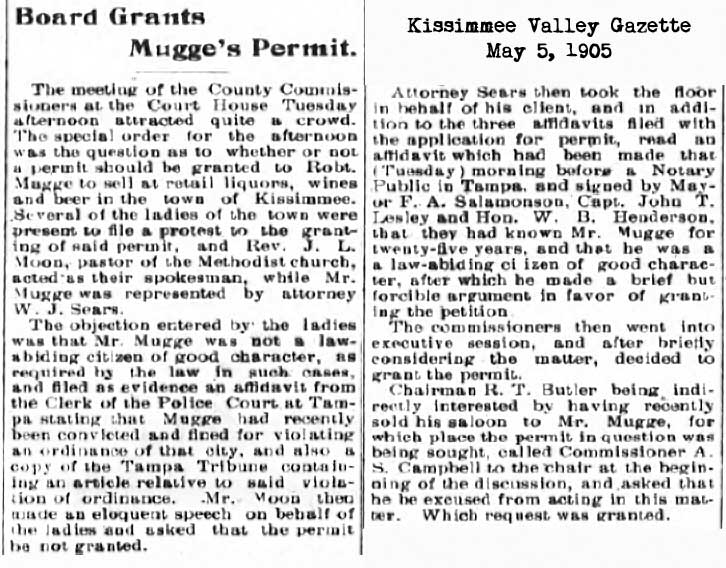 |
|
On May
12, 1905, the Kissimmee Valley Gazette printed a letter
(below) from Chairman of the Board of County Commissioners
R.T. Butler which was sent to the Jacksonville Metropolis.
A week earlier, the Metropolis had printed a letter
"Kissimmee Notes" from the Kissimmee paper which Butler
claims "misrepresented the facts in regard to Mr. Mugge
calling a preacher a liar" and other events which took place
at the May 5th board meeting. Regarding those at the
meeting protesting Mugge's permit application, he points out
that there are "as many or many more people here who would
welcome Mr. Mugge as a citizen than would reject him," and
that not only does Mugge not intend to become a citizen of
Kissimmee, his saloon is not a new business to Kissimmee,
"and the same is conducted by parties who were already in
the business." (For one, R.T. Butler himself, who sold
his saloon to Mugge.) Butler sums up his letter by
stating that the letter to the Metropolis did not bear a
name, and "it would be well for him or her...in future
attacks to confine more strictly to what really happened and
not be so prejudiced." He ends by stating "...I deemed
it necessary for those who might have read 'Kissimmee Notes'
to know the truth of the matter" as he himself was one of
those condemned in the article.
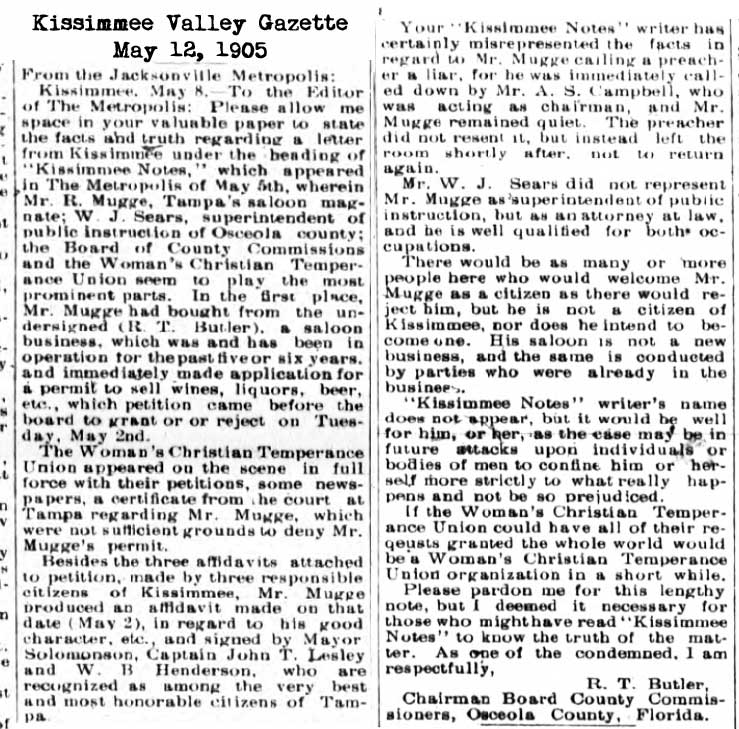 |
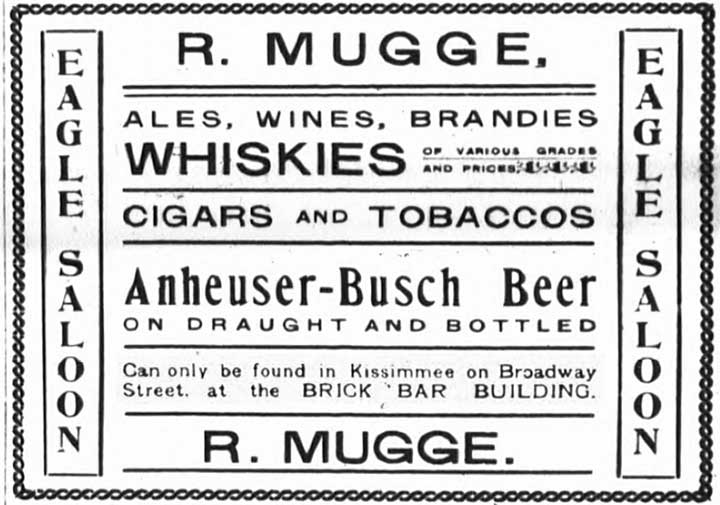 |
Beginning May 12,
1905, Mugge began running this ad in the Kissimmee Valley
Gazette. |
|
1905, May 23rd - Fire in Tampa destroys one of Mugge's
buildings
A fire on May 23rd, 1905
destroyed Mugge's 2-story brick building, 60 ft x 100 ft, on the northwest corner of Franklin and Carew
streets. Mugge then brought suit in
the Circuit Court of Hillsborough County against Tampa Waterworks
for failing to provide adequate fire protection, due to low water
pressure, through a system that was supposed to be "First Class...with a reservoir capable of holding 100,000 gallons of water,
sufficient to give a pressure on the mains from a hydrant located
at the intersection of Washington and Franklin streets, and
through 100 feet of fire hose and a 1-inch nozzle, to throw a
stream of water vertically to a height or distance of 50 feet,
giving a first-class fire protection..."
The Circuit court
dismissed the suit, in favor of the Tampa Waterworks. But Mugge
took the case all the way to the Supreme Court of Florida, where
the judgment was reversed, "Error to Circuit Court, Hillsborough
County, Joseph B. Wall, Judge.
Read about the details of the case,
Mugge vs. Tampa Waterworks Co..
|
|
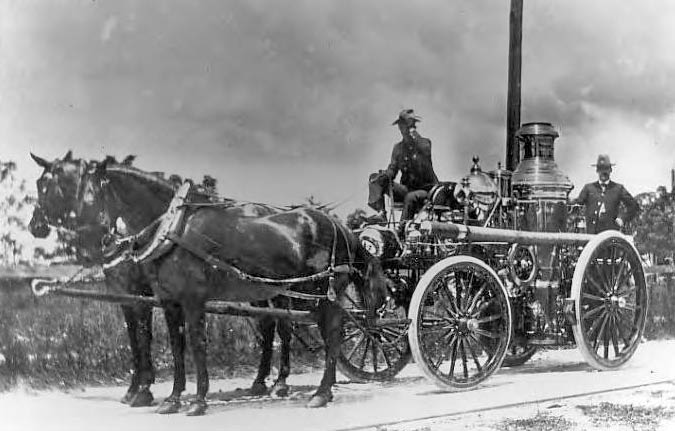 |
|
La
France horse drawn steam piston pumper, named Elmer Webb,
assigned to Station 4 of the Tampa Fire Department.
Burgert Brothers photo from the Hillsborough County
Public Library Cooperative Digital collection. |
CHANGES BUSINESS
INTERESTS
In the early 1890s the first floor of the building in which the
grocery and general store was located was transformed into living
quarters for the family. The building in the back was used for
storage purposes. Robert Mugge abandoned the grocery, general
store and jewelry business. He became the sole owner of the
following enterprises: |
| |
BOTTLING PLANT
It was in the early 1890s (1892-1895) when Robert Mugge built the
Bottling Plant adjoining his home on Marion Street with Caroline Mugge’s garden in between the plant and their home. In the rear of
the Bottling Shop was a huge wooden tank into which water was
pumped daily from a well. (on the 1895 map it is labeled "Raised
20'.) In the shop itself, in one corner was
the boiler room and in another the syrup room where Robert Mugge
concocted the various syrups which were used in the manufacture of
lemon, strawberry, sarsaparilla, and soda water. Old time
machinery, the bottles were individually filled by a machine
operated by the bottler, Robert Mugge. In another corner were the
vats where the bottles were washed. |
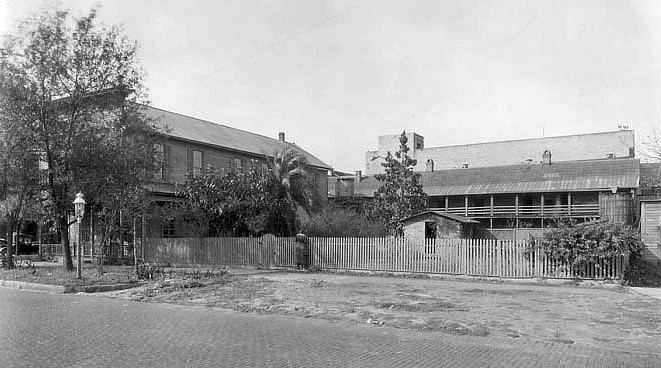
The
location of the Mugge
home, store, and bottling plant (just off camera at the right) at 308 Jackson, 1922.
Burgert Bros. photo from the Tampa Hillsborough County Public
Library digital collection. |
| |
|
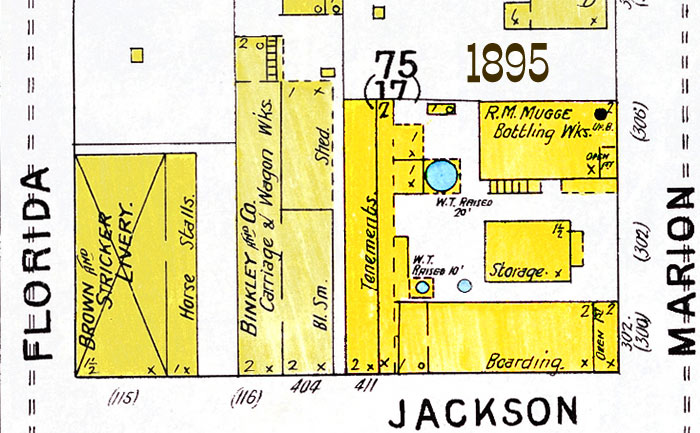
On
the 1892 Sanborn map, the structure seen here marked
"Bottling Wks." was marked "Mineral Water Factory."
(below)
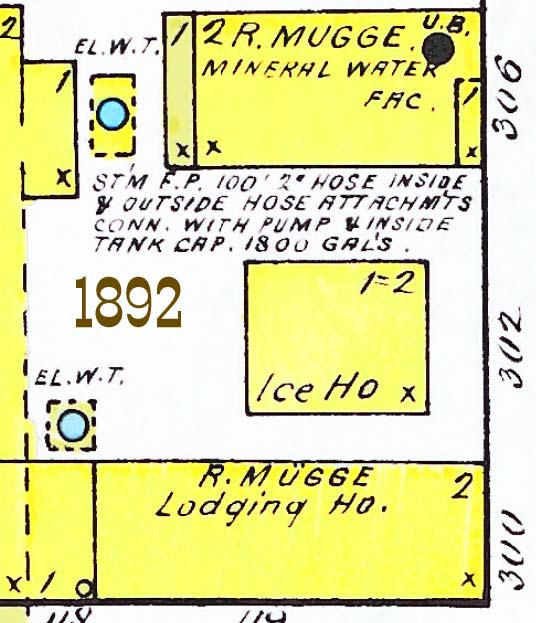 |
| |
|
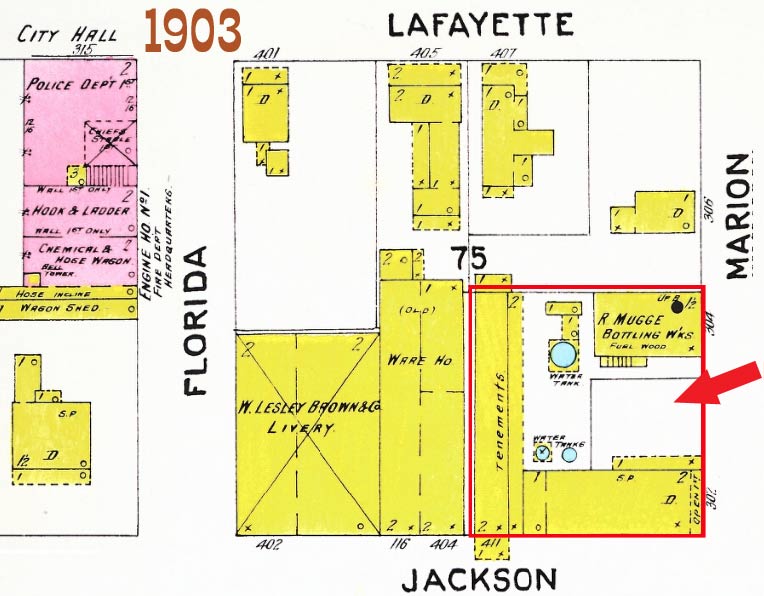
The
1903 Sanborn Fire Insurance map of Tampa shows Mugge's property
was the southeast quarter of the block numbered 75.
Yellow buildings are wood
frame, pink is brick. City Hall, the police dept and fire
dept. can be seen on the block just to the west, at Lafayette St.
and Florida Ave.
The 1922 photo above was
taken from the direction of the red arrow; the bottling plant was
just off camera to the right of the photo.
Map provided by the
University of Florida Digital Library
Map Collection. |
| In the fall of 1988,
during excavation of Marion Street in preparation for the
construction of the Hartline Bus Mall which would provide a central
public transportation hub for Tampans, many broken bottles were
dug up in the area of Jackson and Marion streets. Ironically, Lee
R. Cullens, Jr. of Clearwater, superintendent of Nelson
Construction Company, who was very distantly related to the Mugge
family by marriage and who knew nothing of the family history of
earlier days, brought a bottle home with the name "Robert Mugge"
on it. When Lee Cullens’ nieces saw the bottle they knew
immediately that the bottle belonged to their great, great
grandfather. The bottle had been buried in the ground for over a
century. The unused, broken bottles had been used as a border for
the paths in Caroline Mugge’s garden. Correspondence and
pictures from granddaughter, Marie Mugge Diegelmann of Germany,
confirmed the bottles were indeed used in Caroline Mugge’s garden.
Marie was born in Tampa and lived on Pierce Street during her
childhood and well-remembered the gardens of her grandmother.
ELECTRIC LIGHT & ICE
MANUFACTURING PLANT
In the latter part of the 1880s Mugge built an electric light and ice
manufacturing plant on his property at Central Avenue. It would start to operate at six
in the evening and close down at midnight. Often the lights were
very dim and often there were breakdowns. The boilers were at
first fed with wood hauled from his acreage at Bloomingdale where
the trees were felled and hauled in dummy engines and in teams to
the factory. Later two huge tanks were sunk into the ground filled
with oil which supplied the boilers. The plant never was a
financial success. Mugge was instrumental in the building of an
Electric Light Plant In Port Tampa City, selling, in 1891, the
machinery and equipment adequate for a plant of sufficient power
to serve the town including 25 miles of wire at one-half of what
it would have cost from the manufacturer. There is a letter in
existence dated July 15, 1891 to Captain J. W. Fitzgerald, general
superintendent of the P. & O., in which he made the offer to sell.
The plant was in operation for many years.
|
| |
|
It was imperative that Mugge build the ice plant, since he had
secured the agency of the Anheuser-Busch Brewing Company of St.
Louis, brewers of Budweiser and other beers, draft and bottle. He
eventually went into the wholesale and retail liquor business and
had saloons In all sections of Tampa, St. Petersburg, Port Tampa
City and Plant City. The wholesale establishment was located on
Franklin Street in the 300 block, adjoining the city hall.
DISTILLERY
Robert Mugge became the owner of the first legalized distillery in
the state of Florida. This was located in a wooden structure at
the corner of Cass Street and Central Avenue.
|
| The
1903 Sanborn map below shows the neighborhood of the Electric plant,
Ice plant and Distillery
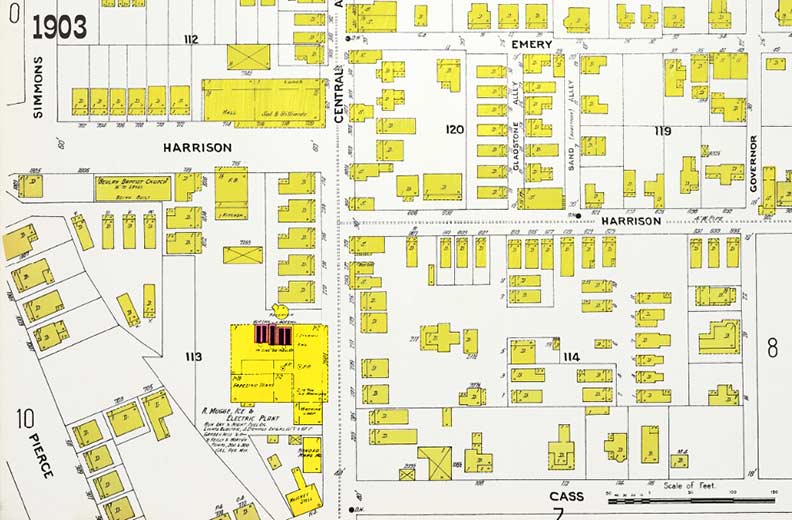
|
| |
NEW ORLEANS-TAMPA TRANSPORTATION LINE
This was created in 1900. The Eva L Shenton, a three-master,
which brought as its cargo, not only his goods, but was
utilized by other merchants in Tampa. He chartered another
ship that ran to Havana and Honduras. This ship sank during
a terrific storm between Honduras and New Orleans. The storm
in 1901 destroyed Galveston and the venture was abandoned.
Robert Mugge owned some property along the waterfront. This
was sold in 1925 to clear the right-of-way for the Platt
Street Bridge.

Merchant Vessels at Google books
|
SUNLIGHT MANUFACTURING
COMPANY (Map at right)
In 1906 Mugge became interested in this company. It produced
individual operated gas installations for small towns where there
were no gas accommodations. He became a stock holder and erected a
two-story brick structure at the corner of Cass and Central Avenue
in which the machine shop was housed. Later the firm went bankrupt
and Robert Mugge took it over. It never was a paying investment
and it was liquidated in 1921.
It would appear
that the Electric and Ice plant was converted for use by his
Sunlight Mfg. Co., but it was not made of brick, it was wood
frame. In place of the dwellings just north of it was built
a 3-story brick building in which the 2nd & 3rd floors was
the Central Hotel. He erected the three-story brick building at the
corner of Central Avenue and Harrison Street which was intended as
a hotel for the black population. The Central Hotel was completed
in late spring of 1914.
Also built by this
time was a 3-story brick building labeled "Negro Club"
just south of the Sunlight Mfg. Co. where Mugge's distillery
was located in 1903.
|
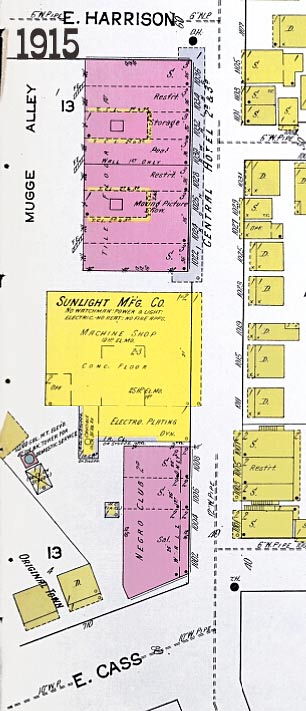 |
|
Mugge's Corner
 The
photo below, taken from 15th Street and 7th Ave. in Ybor
City, looking northwesterly in 1899, shows the north side of
7th Avenue. The intersection was known as Robert Mugge
Corner because of one of Mugge's saloons located on the
corner. It can be seen at the far right, the 2-story wood
structure with the Anheuser-Busch Beer sign above the
awning. The 2-story wood structure (behind the horse
and buggy) is the location of Las Novedades Cafe. The
photo below, taken from 15th Street and 7th Ave. in Ybor
City, looking northwesterly in 1899, shows the north side of
7th Avenue. The intersection was known as Robert Mugge
Corner because of one of Mugge's saloons located on the
corner. It can be seen at the far right, the 2-story wood
structure with the Anheuser-Busch Beer sign above the
awning. The 2-story wood structure (behind the horse
and buggy) is the location of Las Novedades Cafe.
|
| |
|
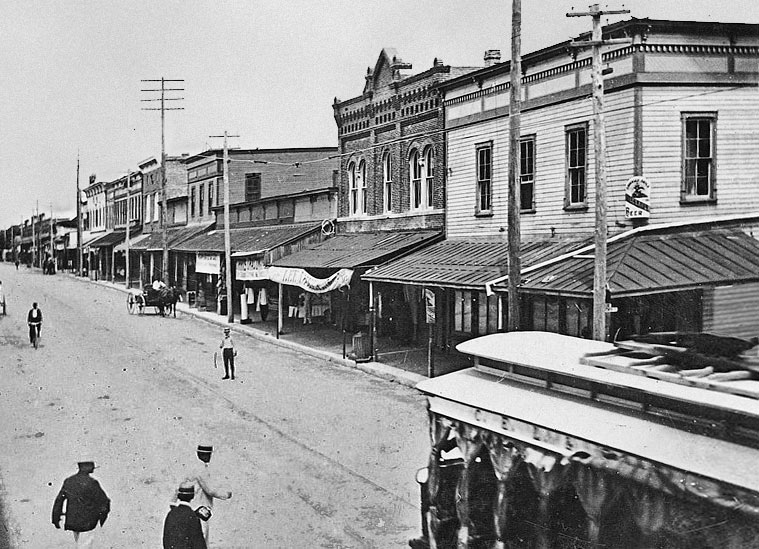
Burgert Bros. photo from the University of South Florida
digital collection.
Place your cursor on the photo to see the buildings
identified. |
|
| ROBERT MUGGE-THE
BUILDER
AMUSEMENT PARK
Mugge operated an amusement park in 1896 in partnership with Bautista M. Balbontin, a Spaniard
cigar manufacturer and wine merchant. It was located
outside the city limits in the eastern part of Tampa known as Palmetto Beach or De Soto Park. A dancing pavilion was built on the property in
connection with a bar. The Forepaugh Family, trapeze artists, gave
open air performances, with a balloon ascension in the afternoon.
The balloon would ascend after having been filled with smoke and a
parachute attached to it. The balloonist would perform all kinds
of stunts before the parachute was detached. The balloon would
fall to the ground or at times in the bay or in a tree. Bowling
alleys were installed and a bath house was built. Great crowds
came, mostly of the Cuban population. The old pavilion stood for
many years even after the park had become city property.
Below, DeSoto
Park circled in green, 1899
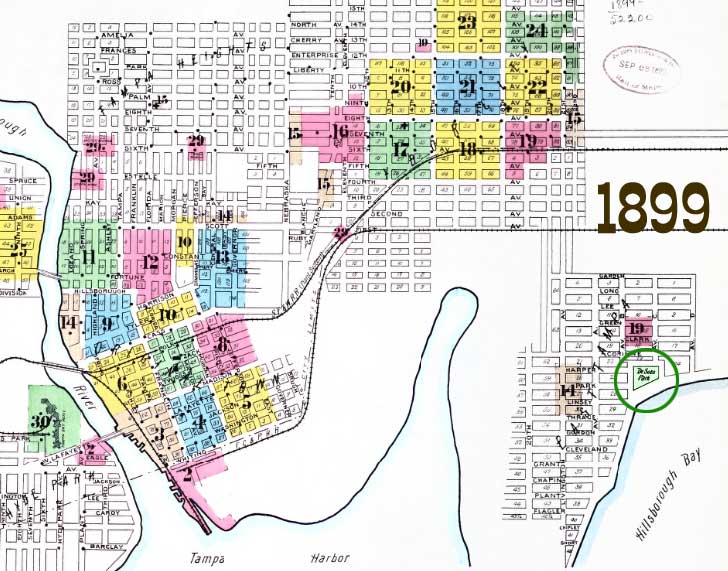
At right is a
composite map which shows the amenities of the park
in 1903 (green area) overlaid onto the street grid
of 1915. 1903 was the earliest map which
showed the amenities of the park, but didn't show
the surrounding street grid in detail.
Link to the 1903 Sanborn map at the UF digital
maps collection. |
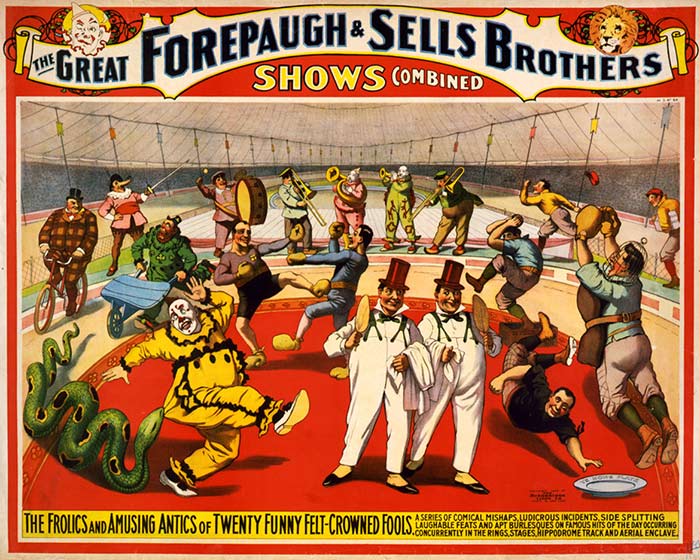
Photo from Wikipedia
Read about the Forepaugh family circus at Wikipedia
|
|
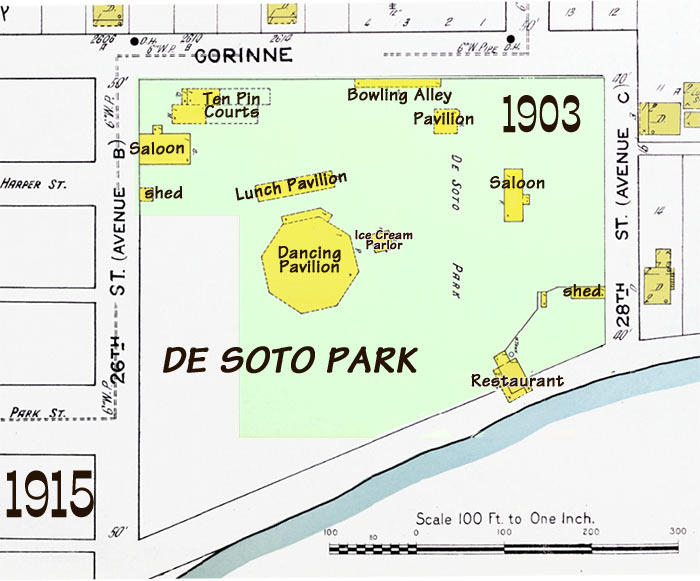 |
From
1900 to 1913, Mugge built a number of brick buildings and houses in
all sections of Tampa. Some of them were:
One-story brick building at the corner of Scott and Central.
Two-story brick building at the corner of Central and Harrison.
Two-story brick building at the corner of Cass and Central.
Two-story building opposite Union Station.
Two-story building at the corner of 7th Ave. and 22nd St.
There were other brick
buildings in West Tampa.
In 1906 Mugge leased a
vacant lot at the northwest corner of Cass and Franklin Streets
for 20 years and proceeded to erect a two-story brick building.
Before it was completed, the second floor, which was to be
occupied by an Armory was destroyed by fire.
|
|
From the Florida Memory Blog
Bone Dry: The Road to Prohibition in Florida
The
question of whether and how to regulate or prohibit the
sale of strong drink had been brewing in the individual
states long before Congress dealt with the matter. In
Florida, as in many states, the issue was hotly contested.
Advocates of prohibition, or the “drys,” argued that
liquor production and consumption was destructive to
society and ought to be outlawed for the sake of health
and the integrity of the family. Those who opposed
prohibition, known as “wets,” countered that the
government had no business interfering so deeply into the
personal lives of citizens. Breweries and liquor
distilleries added that to outlaw strong drink would
destroy the jobs they provided to their workers.
The
solution in Florida, for a time, was to provide each
county with the option of whether to allow the sale or
manufacture of liquor. A number of counties did become
“dry” by vote of the local citizens, and they assured the
rest of the state they were quite satisfied with the
results. A.G. Campbell, the mayor of DeFuniak Springs,
wrote in 1907 that he was sure that the crime rate in his
town was very favorable to that of any wet town of the
same size. W.B. Thomas, mayor of Gainesville reached much
the same conclusion that year, noting that the total value
of taxable property in the city was at least twice what it
had been before the county went dry.
As
time moved forward, prohibition became more political. The
nationwide Anti-Saloon League began reporting on the
progress of individual states toward prohibition, taking
note of which politicians did or did not favor ending the
sale and production of liquor. Carry Nation, the infamous
anti-saloon activist who gained notoriety for smashing up
bars with her hatchet, toured the Sunshine State in 1908
promoting a statewide prohibition law. She also endorsed
Governor Napoleon Broward, who shared her views on
spirituous drink and was up for reelection that year.
Whatever the
voters’ beliefs on prohibition, no third party had come
anywhere close to defeating the Democrats in Florida since
Reconstruction. Democratic primary candidate Sidney Catts
took the Democratic Party establishment by surprise when
he was declared the winner of the Democratic nomination
following the primary in June 1916. Catts renewed
his campaign efforts, however, and on Election Day in
November 1916 he came away with the victory as governor of
Florida. Sidney Catts would be the only non-Democrat to
win the governorship between the end of Reconstruction in
1877 and the election of Republican Claude Kirk, Jr. in
1966.
By this time, the
number of counties having voted to prohibit the sale and
manufacture of liquor had increased, but statewide
prohibition was still on the table. Bolstered in part by
Catts’ encouragement and also by the nationwide movement
toward prohibition, the issue was finally approved by the
state legislature in 1917, ratified by the voters in 1918,
and put into effect in 1919. The legislature also approved
the 18th amendment to the U.S. Constitution, which
prohibited the sale and manufacture of liquor nationwide.
Although Florida would be the setting for many violations
of the prohibition law during its short lifetime, the
Sunshine State would mostly be, as the saying goes, dry as
a bone.
|
Below is the
beginning of a lengthy July 9, 1909 article in the Ocala
Star, followed by Florida Senator Donald C. McMullen's
response in a letter.
He is responding
to a letter (the "Wells article") by the
anti-prohibitionists which stated if the amendment
is ratified by the people, it will be ineffective due to
the way it is structured and worded. McMullen
responded with a long and verbose defense of the
amendment, and summed it up with:
If anybody
thinks that the liquor people believe with the author of
the Wells article that the proposed amendment will be
'void if adopted,' just let them wait and see if the
liquor people fight the adoption of it.
But their
fight is a losing one. Robert Mugge, the biggest
liquor dealer of this city, and possibly the largest
individual dealer in the state, said in an article
published in the Tampa Times of July 2nd (1909), that he
expected to be looking for another position in about two
years.
He ends with
inflammatory statement to stir up the prohibitionists and
a prediction on their margin of victory.
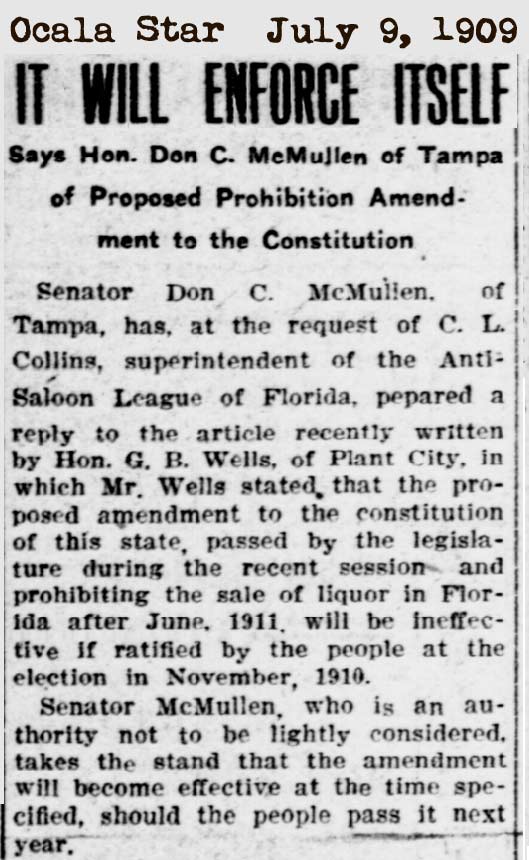
See
the whole article here. (Click the article to enlarge
full size.)
District 11,
McMullen, Donald C., 1909-1912
Florida state senator who drafted the legislation to
create Pinellas County. Another relative, Joel McMullen,
was the first mayor of Largo in 1905.
|
|
It wasn't until 1911
that Pinellas severed from Hillsborough to become a
separate political entity. Donald C. McMullen was a state
senator and had pledged to get the enabling legislation
before the senate. His predecessor had blocked passage in
the previous session. The St. Petersburg Times stoutly
advocated the Hillsborough-Pinellas division, but it was
just as vociferously opposed by the Tampa Tribune and
Tampa Times, and by Tampa’s business leaders like Peter O.
Knight.
Senator McMullen
was a man of his word, and the controversial bill became
law. He may have paid a political price, however, for he
did not serve in the senate after 1911. Known as an able
lawyer but perhaps better known as an avid prohibitionist,
the senior McMullen once debated the issue in Tampa
Auditorium with Clarence Darrow. He reportedly acquitted
himself ably and well.
As his son, Neil,
did years later, he became president of the Bar
Association in Tampa. His sons, Fred and Neil, practiced
as an integral part of Donald C. McMullen and Sons in the
Petteway Building at the northwest corner of Twiggs and
Florida Avenues.
When the former
senator died thirty-six years after standing by his
position despite opposition by the press in Tampa, the
Tribune lauded him editorially as an uncompromising
exemplar of public and private morals.
Chips Off the Old Bench- Neil C. McMullen,
Hillsborough’s Connection to Famous Family of Pinellas
by Morison Buck,
USF Digital Collections
|
|
1910 U.S. Census, Hillsborough County, City of Tampa
Click image to see larger.
 |
|
This census indicates
that Caroline was Robert's second wife they had been married for 27
years, this being Caroline's first marriage. This census
also shows "Lannie" of the previous census was actually "Melanie".
Another daughter of Robert and Caroline was born after the previous
census; Nellie B. The 1910 census provides
more detail in regard to middle initials: Louise M., Eugene G.,
Frances B., August B. (who is of age to have been the "Albert" listed in
1900) Melanie W., Martha W., and Nettie B.
Robert & Caroline's daughter Louise had been
married for 6 years, but her husband (Herman H. Regener) is not listed
in the household, and she is listed as a Mugge., The widowed sister of
Robert Mugge is still in their home in 1910. Bertha Berger,
widowed, who was married the first time to William Mahn, apparently
remarried to a Mr. Berger who also passed away. Robert's daughter-in-law
Wilhelmina Mugge was the wife of Eugene Mugge. She and Eugene had
been married for 3 years. She was the mother of 2 children, with only
one living, but oddly, their child is not listed in the home.
Eugene was a travelling jewelry salesman, and Robert's occupation was
wholesale liquor dealer. Robert & Caroline's son, August B. Mugge,
was 19 and listed as a student. See section about August later in
this feature.
On the 1920 census, Caroline is widowed,
August is married and his wife is "Minnie" who is listed in the
home as daughter-in-law to Caroline.
On on the 1930 census,
August is found doing quite well in a home valued at $10,000 on Sunset
Drive in Suburb Beautiful (today's Bayshore Blvd. area) with wife
"Minna"and 4 children. August was the president of a real estate
company.
|
Tampa's
skyline grows upward in 1912
Tampa's skyline was
jabbed by skyscrapers for the first time in 1912 when the
eight-story, 320-room Hillsboro Hotel was completed and two
ten-story giants were started--one by Robert Mugge and the other
by the Citizens Bank & Trust Company, headed by John Trice.
Robert Mugge, builder of
one of the first ten-story skyscrapers, first attracted attention
in December, 1884, when he put up the first street lights in town
in front of his Jackson Street home and bottling plant. The lights
burned oil. At that time he also laid the first concrete sidewalk.
Said the TAMPA TRIBUNE: "Mugge's
example is one that many other good citizens would do well to
follow."
Six years later, in
April, 1890, Mugge organized the Tampa Electrical Illuminating
Company, installing a generator in his ice plant on Central
Avenue, and started supplying electricity to the scrub district.
But he could not get a street lighting contract from the city and
the venture was unprofitable.
He more than made up for
his loss, however, through his wholesaling of alcoholic beverages.
His business grew year after year. Foreseeing even better business
in 1898 when Tampa was first mentioned as an embarkation point for
troops for the Spanish-American War, he wired the Anheuser-Busch
Company for a trainload of beer. The company wired back: "There
won't be a war and we don't sell beer by the trainload." But there
was a war and Mugge did get beer by the trainload--and he profited
handsomely.
BAY VIEW HOTEL
|
In
1912 Mugge built a ten-story warehouse on Jackson Street between
Franklin and Tampa Streets. It was a very unsuitable location with
no railroad track or wharf. The building was built of reinforced
concrete. After its completion, he planned to change it into a
hotel at an enormous expense. On each floor there was a large,
ornately decorated lounge. Said Mugge "The way I’ve got it figured
out this hotel is a cross between a YMCA and a ten-story bar
room." The finished hotel was completed in January 1915 and was
called the Bay View. The formal opening took place on Jan. 16,
1915. The hotel was demolished in 1980 to make way for the Paragon
Building (now the 5th 3rd Bank).
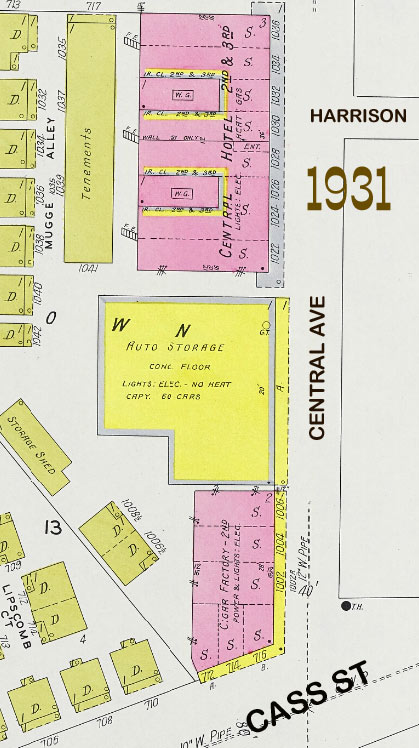
1931 Sanborn map showing location of the Central hotel.
By 1931 the Sunlight Manufacturing Co. was replaced with
auto storage, and the "Negro Club" south of it became a
cigar factory. |
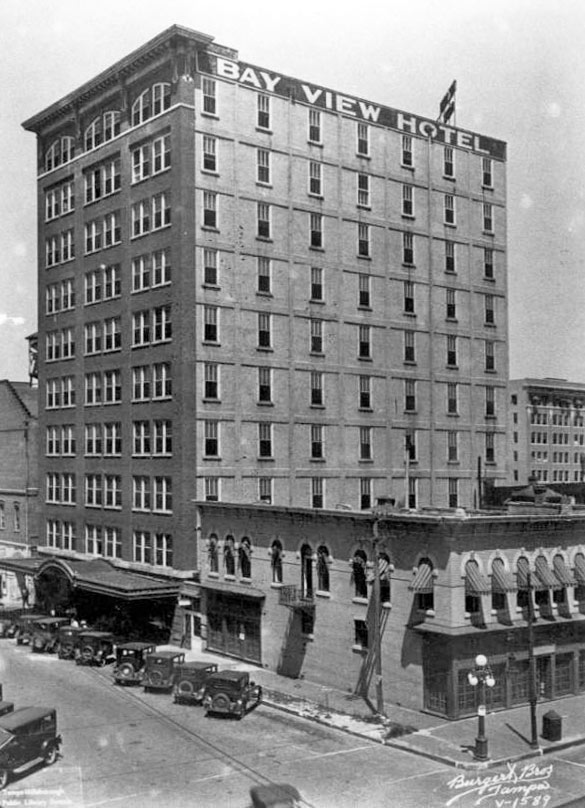
Bay View Hotel -
Tampa, Florida. 1930.
Burgert Bros. photo from
State
Archives of Florida, Florida Memory.
| Robert Mugge never
employed an architect. He had a foreman by the name of B. H.
Davidson. He would inform him of his plans and gave him a free
hand. Robert Mugge’s son, August B. Mugge, returned from his
schooling in Germany with a degree in engineering and architecture
and in 1914 supervised the completion of the Bay View Hotel with
Mr. Davidson as foreman. |
|
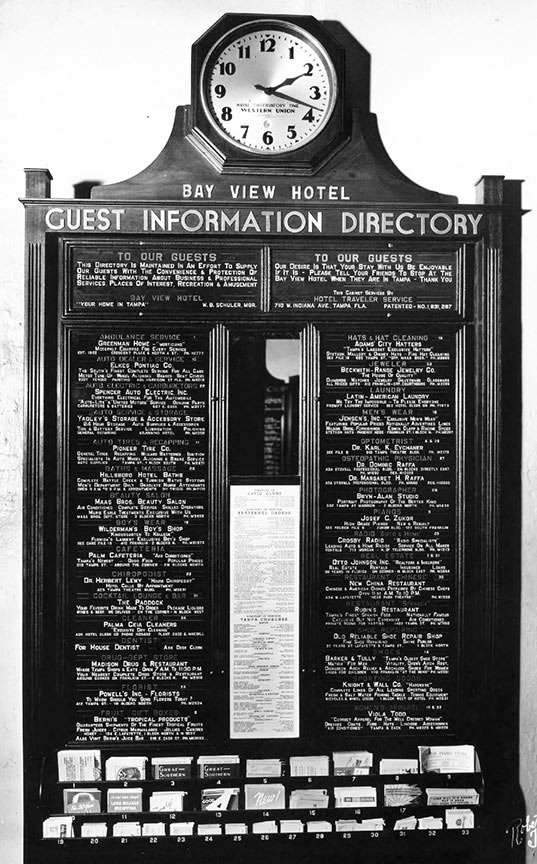
Bay View Hotel guest
directory
1942
From Burgert Bros. photo
from the University of South Florida digital collection.
See a full size front
view photo of the guest directory seen in the front desk photo, on
the left wall.
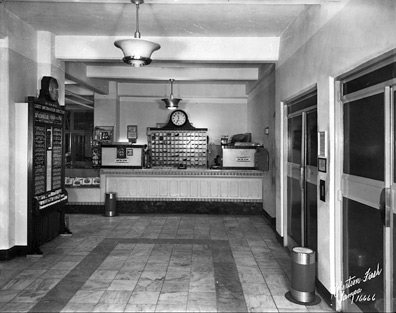
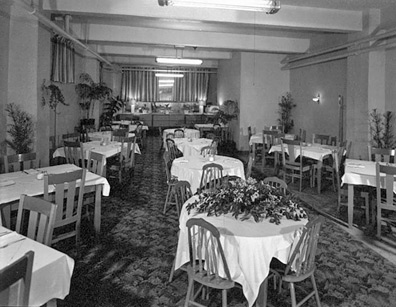
The Bay View front desk in 1942 and
Dining Room in 1948
Bay View Hotel
Demolition, 1980
|
|
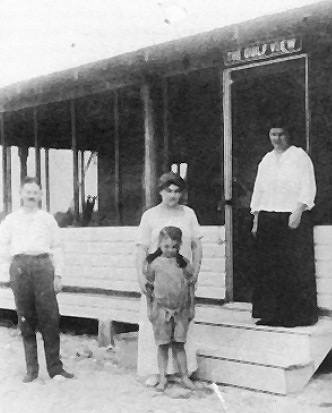 |
|
THE MUGGE
BEACH HOUSE
The Gulf View, the Mugge beach house, about 1914. Left to right,
Fritz Petri, Mrs. Eugene (Mimi) Mugge, daughter-in-law and her
daughter Marie, and Mrs. Caroline Mugge. |
BEACH HOUSE
In 1912 he built a summer home for the family in Anna Maria Key. The
entire family took turns in visiting the island every summer. Robert
Mugge never saw the house. The house stands to this day (1989) and is
owned by Fernando and Gladys Torres of Tampa.
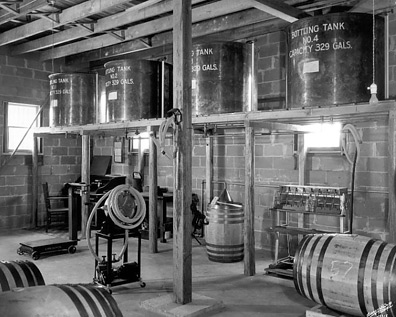
E. (Eugene) Mugge Wholesale Liquors at 4190 E.
Hillsborough Ave., 1935 (above) and 1937 (below)
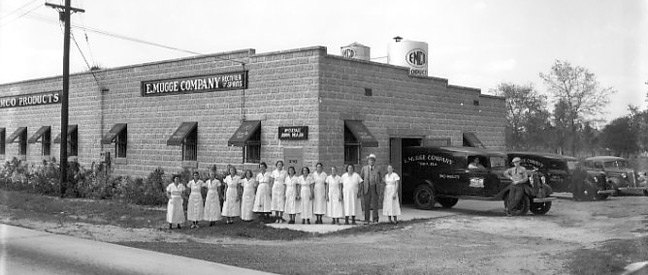
ROBERT MUGGE AND THE
SPANISH-AMERICAN WAR, 1898
In 1898, during the
Spanish-American War, American troops were brought to Tampa by rail and
they marched up Franklin Street to the northern part of the city where
many were encamped. The camp was in the neighborhood of Michigan Avenue
(now Columbus Drive). The soldiers were mostly volunteers from the west
and were commanded by General Shafter, who had his headquarters in the
Tampa Bay Hotel. Robert Mugge built a large saloon in an orange grove
near the camp. The contractor had to build the entire structure in one
day, including fixtures. The counter had a length of 80 feet and the
soldiers were served by eight bartenders. It was open at all times and
was known as the "Noah’s Ark."
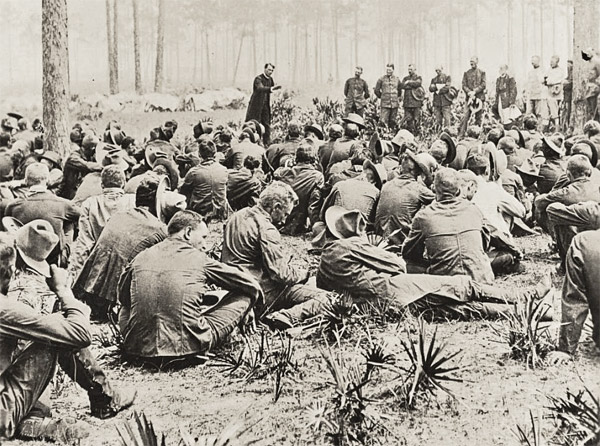
Rough Riders listening to a
service delivered by chaplain Henry A. Brown, with Theodore Roosevelt,
Leonard Wood, Joseph Wheeler and other officers standing next to the
tree in the right of the photograph.
When Tampa was first mentioned as an
embarkation for the troops, Robert Mugge, who owned the franchise for
selling August Busch's Budweiser beer on Florida's west coast,
anticipated the arrival of 30,000 potential customers, courtesy of the
U. S. government. He wired the Anheuser-Busch main office for a
trainload of beer. An indignant Busch wired back: "There will not be a
war and we do not sell beer by the trainload." But there was a war
and he got beer by the trainload, and he sold every drop of it. The
"Green Goose Saloon" in Port Tampa also was supplied. The soldiers
embarked from Port Tampa for Cuba, in all about 50,000 men. On the day
the treaty was signed in August, the Noah’s Ark was destroyed by fire.
Robert Mugge - The Man
Clad only with an undershirt, trousers, shoes and coat, Mugge would
conduct his business. He wore bluish linen clothes, winter and summer
the same and he was spotlessly clean. He was endowed with boundless
energy, going full speed an average of 18 hours out of 24. He never
employed a bookkeeper, nor owned a typewriter or adding machine. His
office was a small space in the center of the wholesale establishment on
Franklin Street where you could see a high desk with a stool and in the
back of this, a small table and arm-chair. He transferred by hand from
the order book to the bills which had to be collected on Monday morning.
All letters were written by hand, no receipts kept, he had a remarkable
memory and could give you an answer at a moment’s notice. He could talk
with you while he was writing letters or listening over the phone. At
this time he would converse with Mr. Davidson, his plumbers or
electricians in reference to a building under construction. He would
read the daily papers while he was eating. In 1901 he became a member of
the Board of Public Works. He aided many worthy causes, among them the
Children’s Home located on Washington and Marion Streets. His name
appeared on the list of the month as one of the highest contributors.
In 1908 he wrote a book, in
conjunction with Captain John R. Jones of Anna Maria Key, entitled
"Practical Humanity." The book was published. The Library of
Congress is unaware of any copyright restrictions for this item.
This work has
been selected by scholars as being culturally important, and is part of
the knowledge base of civilization as we know it. It was reproduced from
the original artifact, and remains as true to the original work as
possible. Therefore, you will see the original copyright references,
library stamps (as most of these works have been housed in our most
important libraries around the world), and other notations in the work.
This work is in
the public domain in the United States of America, and possibly other
nations. Within the United States, you may freely copy and distribute
this work, as no entity (individual or corporate) has a copyright on the
body of the work.
Excerpt from Practical
Humanity: A Suggestion for the Destruction of Poverty, the Curbing of
Cupidity, and the Lessening of Crime:
Good old Mother Nature can
be made to produce an abundance to supply every human being on earth,
with all the necessaries of life, all the comforts and not a few of the
luxuries. Read this little book and learn how.
CHRISTMAS IN
FEBRUARY
"It is told that
Mr. Mugge operated the only store here which dealt in Christmas toys
and such articles. One holiday season he had ordered his usual
shipment from Mobile, which was to come forward by schooner. The
Christmas ship was caught in a storm and was damaged so badly that it
was necessary for it to go into dry dock for several weeks, missing
its trip to Tampa. As Christmas approached and no consignment of toys
had been received, nor any possibility for receiving them was held
out, it was decided to postpone Christmas. Many native Tampans or old
time residents of the city remember the postponed Christmas. The ship
finally arrived along in February, according to Sheriff W. C. Spencer,
who was a child at the time and upon whose mind the delayed
celebration was greatly impressed. With the receipt of Christmas goods
by Mugge’s store, arrangements were made for an unseasonal visit of
Santa Claus, and Christmas went off just as if the ship had been on
time and Santa had made his usual rounds on December 25.
end newspapers
http://ufdc.ufl.edu/UF00075924/00181/1x?search=mugge
 obert Mugge
died on Dec. 17, 1915, at age 63, and was buried in a newly acquired family
plot in Woodlawn Cemetery. The funeral was reported to be one of the
largest ever held in Tampa and was held from the family home on a Sunday
morning. Robert Mugge devoted his life to the building of Tampa which he
loved so well. He would invest every dollar he made in Tampa thereby
giving employment to thousands of breadwinners. He was a law-abiding
citizen and would not tolerate any violation of any kind by his
employees. He and his estate in later years paid well over $1,000,000 in
City and County taxes in addition to a large number of occupational
licenses.
Upon his death, The Tampa Tribune published this eulogy: obert Mugge
died on Dec. 17, 1915, at age 63, and was buried in a newly acquired family
plot in Woodlawn Cemetery. The funeral was reported to be one of the
largest ever held in Tampa and was held from the family home on a Sunday
morning. Robert Mugge devoted his life to the building of Tampa which he
loved so well. He would invest every dollar he made in Tampa thereby
giving employment to thousands of breadwinners. He was a law-abiding
citizen and would not tolerate any violation of any kind by his
employees. He and his estate in later years paid well over $1,000,000 in
City and County taxes in addition to a large number of occupational
licenses.
Upon his death, The Tampa Tribune published this eulogy:
|
A GREAT MAN GONE
Robert Mugge was an old
citizen of Tampa but not an old man, and was a remarkable
character. A man of intelligence and business acumen. One of the
most enterprising of our citizens. A man of energy; he fought the
battles for fortune unsurpassed though afflicted physically. This
was a "great" man, though few people knew it, nor did he.
Greatness does not consist in any one attribute. There are many
kinds of greatness. Mugge was great in his defiance of public
opinion. Fashion and customs he did not regard. He was great in
that he had a courage that the mediocracy do not know.
I am going to say that
this man was earnestly honest, and honesty is a virtue. I do not
believe that he loved money, but he certainly did like the game of
finance. |
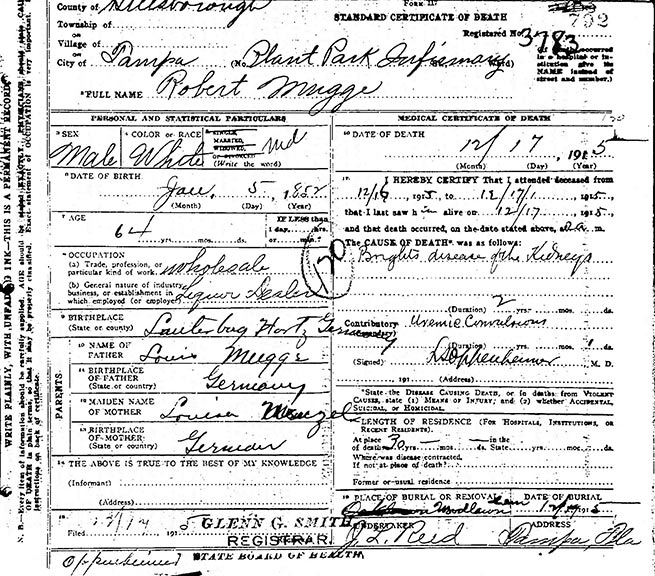
Robert Mugge's death
certificate shows he was a son of Louis Mugge and
Louisa Manzel.
Robert died of "Bright's disease of the kidneys."
His doctor
was a Tampa icon, Dr. Louis Oppenheimer.
|
Had he been worth $20,000,000 he would have been the same plain,
simple, earnest working man. I knew him, I thought quite well of
him, and I know that he was a friend to his friends. Though he was
a much hounded and persecuted man, it is a fact that he cared
little for the javelins of his enemies - those who did not see
things as he did. He was a "strong" man, I mean a "great" man.
|
|
Mugges
Interred in Woodlawn Cemetery, Tampa |
|
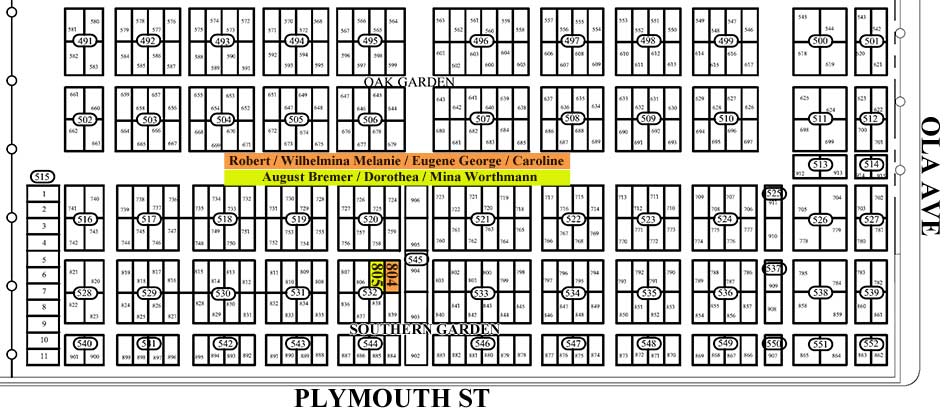 |
|
Enlargement above is the blue area below. |
|
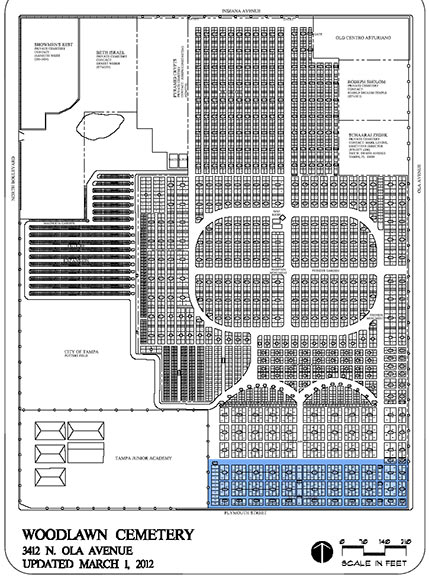 |
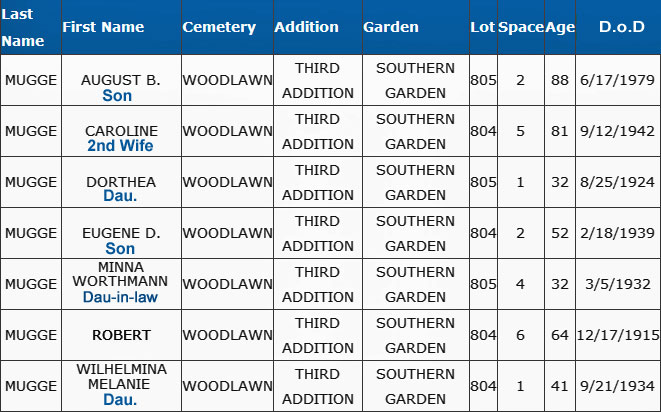 |
|
|
|
AUGUST BREMER MUGGE
August B. Mugge
was born in Tampa on Sept. 10, 1890. He had unusual educational
advantages, both in this country and in Germany. After a few
years in the public schools of Tampa, his father sent him to Germany
at the age of 13, and he spent ten years as a student in the technical
training courses of the universities of Darmstadt and Stuttgart,
graduating from both of these world-famous institutions. He was
trained in these colleges as an engineer and an architect.
Returning to
Tampa, Mr. Mugge entered business with his father and was in position
to succeed him in the management of his numerous interests when the
elder Mr. Mugge died in 1915.
|
 |
|
The Mugge Hotel in West
Tampa
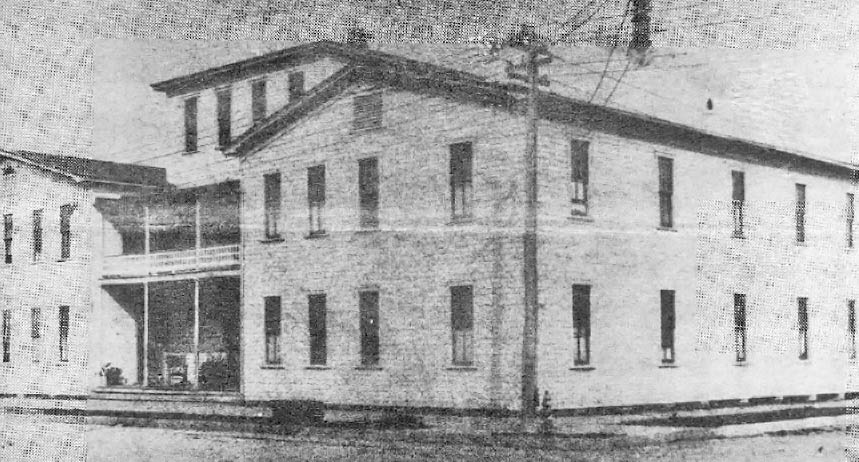 |
|
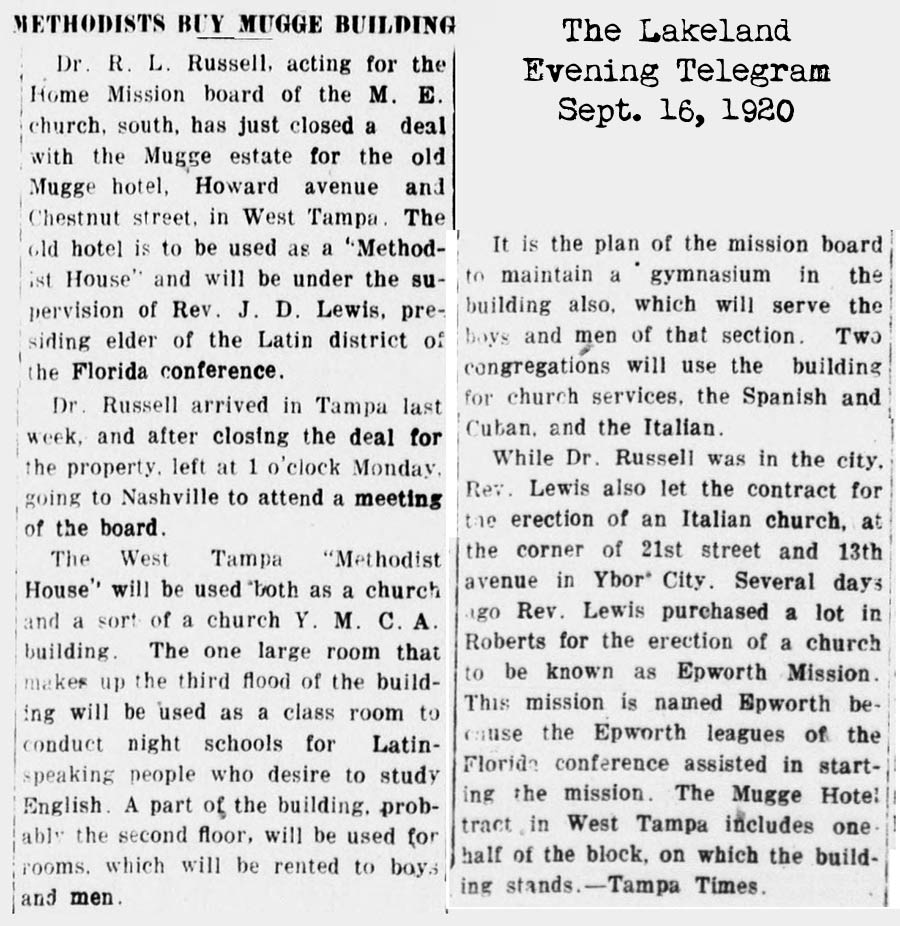 |
In 1922, Caroline Mugge and
three of her daughters moved into a new home on Hills Avenue in Hyde
Park. The family home and buildings on Marion and Jackson Streets were
demolished and a two-story brick building was erected on this property.
The building was leased to a Ford Agency for ten years. Presently, 1989,
a ground level parking lot is located on this property.
The story behind the painting of
Robert Mugge
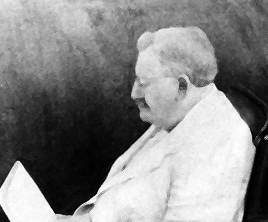 At
the time the Bay View Hotel was completed, Robert Mugge installed
bowling alleys and pool tables on his property on Franklin Street. On a
Sunday morning in 1915, a photographer appeared and wished to take a
picture of the alleys. On the finished picture, in the left-hand corner,
appeared Robert Mugge reading the newspaper. This being the only picture
of Mr. Mugge known to be in existence, the photographer enlarged the picture and
shaded in the background dark. A few years following Mr. Mugge’s death,
his son August Mugge observed some paintings of former Tampa mayors on
the walls of various council chambers. He secured the name of the artist
from former Mayor D.B. McKay. A German artist, Wilhelm Teschner,
was given permission to paint, in oil, this enlarged picture at a cost
of $25. The artist had received small advances on the promised $25 and
when the picture was finished the family was so well pleased they gave
him an additional $75. A few months later the artist’s body was found in
an attic in Ybor City, with a brush and palette in his hands. He must
have died of a heart attack. Since the artist had no relatives, the City
of Tampa provided a lot in Woodlawn Cemetery and friends donated money
to pay for funeral expenses. A Methodist minister officiated. At
the time the Bay View Hotel was completed, Robert Mugge installed
bowling alleys and pool tables on his property on Franklin Street. On a
Sunday morning in 1915, a photographer appeared and wished to take a
picture of the alleys. On the finished picture, in the left-hand corner,
appeared Robert Mugge reading the newspaper. This being the only picture
of Mr. Mugge known to be in existence, the photographer enlarged the picture and
shaded in the background dark. A few years following Mr. Mugge’s death,
his son August Mugge observed some paintings of former Tampa mayors on
the walls of various council chambers. He secured the name of the artist
from former Mayor D.B. McKay. A German artist, Wilhelm Teschner,
was given permission to paint, in oil, this enlarged picture at a cost
of $25. The artist had received small advances on the promised $25 and
when the picture was finished the family was so well pleased they gave
him an additional $75. A few months later the artist’s body was found in
an attic in Ybor City, with a brush and palette in his hands. He must
have died of a heart attack. Since the artist had no relatives, the City
of Tampa provided a lot in Woodlawn Cemetery and friends donated money
to pay for funeral expenses. A Methodist minister officiated.
The above comes from the
Sunland Tribune, Journal of the Tampa Historical Society, Vol. 15, Nov.
1989. "Robert Mugge, Pioneer Tampan, by Margaret Regener Hunter.
Margaret Regener Hurner is a granddaughter of Robert Mugge.
She used as sources,
Information taken from: "Memoirs " a biography of Robert Mugge, authored
by his son, August B. Mugge. Also from the book "Tampa" by Karl H.
Grismer, and various newspaper clippings over the years.
UPDATE - Jan. 21, 2018
| |
|
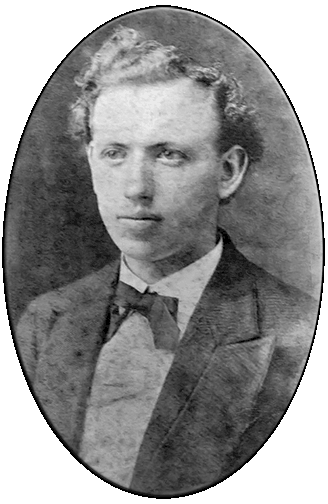 |
|
Family
portrait of Tampa businessman Robert Mugge, courtesy of his great
grandson Robert Mugge. |
Robert Mugge,
world renowned music filmmaker, great grandson of Tampa businessman
Robert Mugge, has located a family photo of his great grandfather which
casts doubt on the Burgert/Tony Pizzo photo shown below. At right
is the real, young Robert Mugge. You can see there isn't any
resemblance to the Burgert/Pizzo photo.
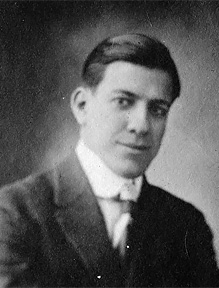 This portrait
at left supposedly taken by the Burgert Brothers photographers in 1899 is part of the Tony Pizzo collection at the University of Florida Digital
Collections, George A. Smathers Library. This portrait
at left supposedly taken by the Burgert Brothers photographers in 1899 is part of the Tony Pizzo collection at the University of Florida Digital
Collections, George A. Smathers Library.
The photo was originally
described as "A Portrait of Robert Hugge" but upon contacting the
librarian, a re-check of the back of the photo revealed that "Hugge"
was a typo and it was indeed "Mugge." Although the title was
corrected, the citation still carries "Hugge" in the title.
See the citation and link to the full size photo here.
It is apparent that
the one on the left is not Robert Mugge.
Mr. Pizzo was an accomplished Tampa historian whose photos were donated to
several library archives in Florida. Other photos from Mr.
Pizzo's collection can be found at the University of South Florida
Special Collections and the Florida Memory Project.

 This
photo was taken in
1899. It shows "Robert Mugge Corner" in
Ybor City. This
photo was taken in
1899. It shows "Robert Mugge Corner" in
Ybor City.
So named because of one of his saloons on the corner of
7th Avenue and 15th Street.
At right is an enlargement of
the sign posted on the corner of the building, it appears to read
"Anheuser Busch, Pale Lager Beer."
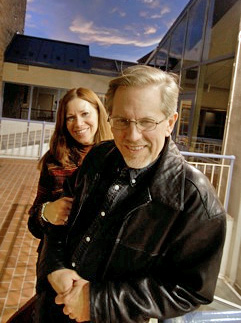
 Robert Mugge's
great-grandson, Robert Mugge, is an accomplished veteran
music filmmaker known the world over. He's received countless
honors and accolades for his work in the music documentary film industry
and is holder of the Edmund F. and Virginia B. Ball Chair in
Telecommunications at Ball State University. Robert Mugge's
great-grandson, Robert Mugge, is an accomplished veteran
music filmmaker known the world over. He's received countless
honors and accolades for his work in the music documentary film industry
and is holder of the Edmund F. and Virginia B. Ball Chair in
Telecommunications at Ball State University.
If you're wondering how to
pronounce his surname, he says it's pronounced "Muggy, like the
weather."
Read
more about Robert at his website.
At left, Robert directs the
filming of a concert around 2010,
photo by Chris Bergin for the Muncie Star Press.
At right, Robert and his
wife/production partner Diana Zelman at the
Starz Denver International Film Festival. Photo by Larry Laszlo
for the festival.
Don't miss Robert's website at
www.robertmugge.com!
|








 This
steamship was built by Card & Co. of Greenock, Scotland for
Norddeutscher Lloyd (North German Lloyd). She weighed 2,992 gross
tons, had a length of 328 feet and a beam of 42 feet, one funnel,
three masts, and a single screw. Her service speed was 11 knots.
There was accommodation for 75 first-class, 105 second-class, and
480 third-class (steerage) passengers. She had a crew of 102.
This
steamship was built by Card & Co. of Greenock, Scotland for
Norddeutscher Lloyd (North German Lloyd). She weighed 2,992 gross
tons, had a length of 328 feet and a beam of 42 feet, one funnel,
three masts, and a single screw. Her service speed was 11 knots.
There was accommodation for 75 first-class, 105 second-class, and
480 third-class (steerage) passengers. She had a crew of 102.











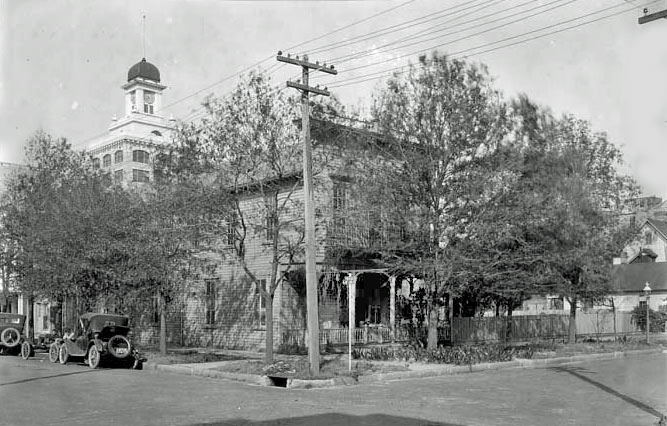




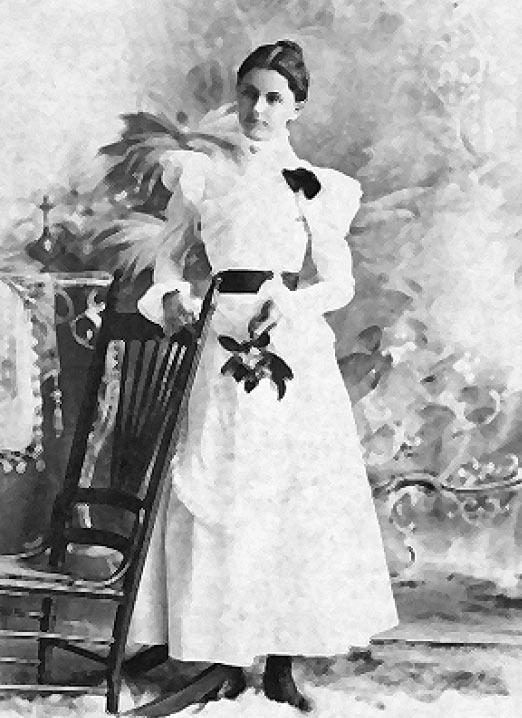








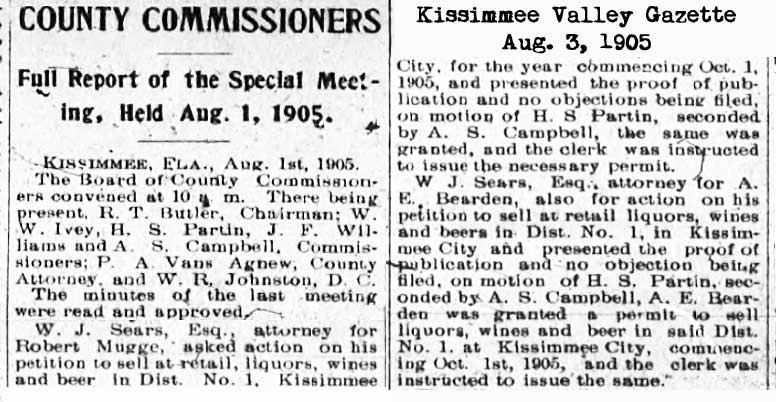
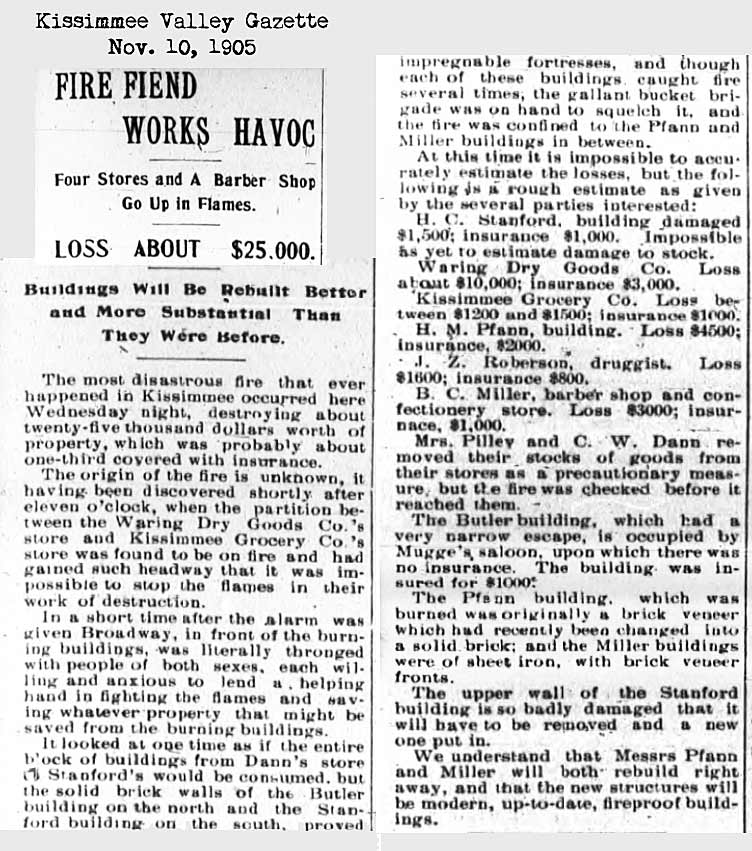
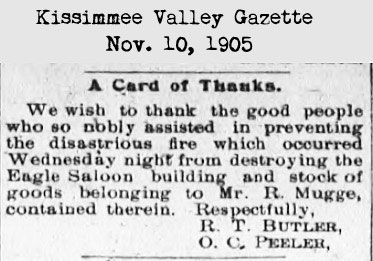




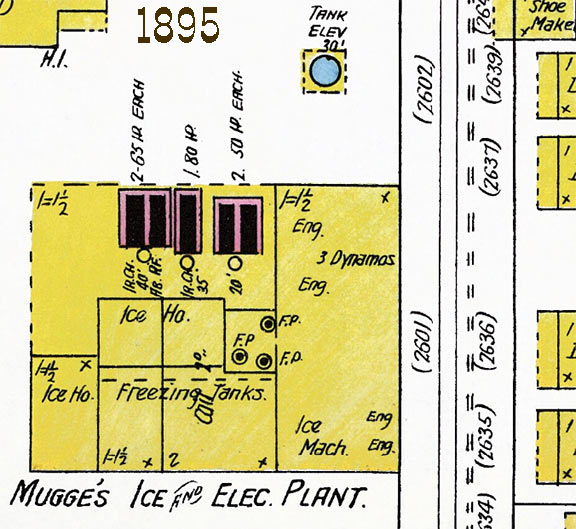
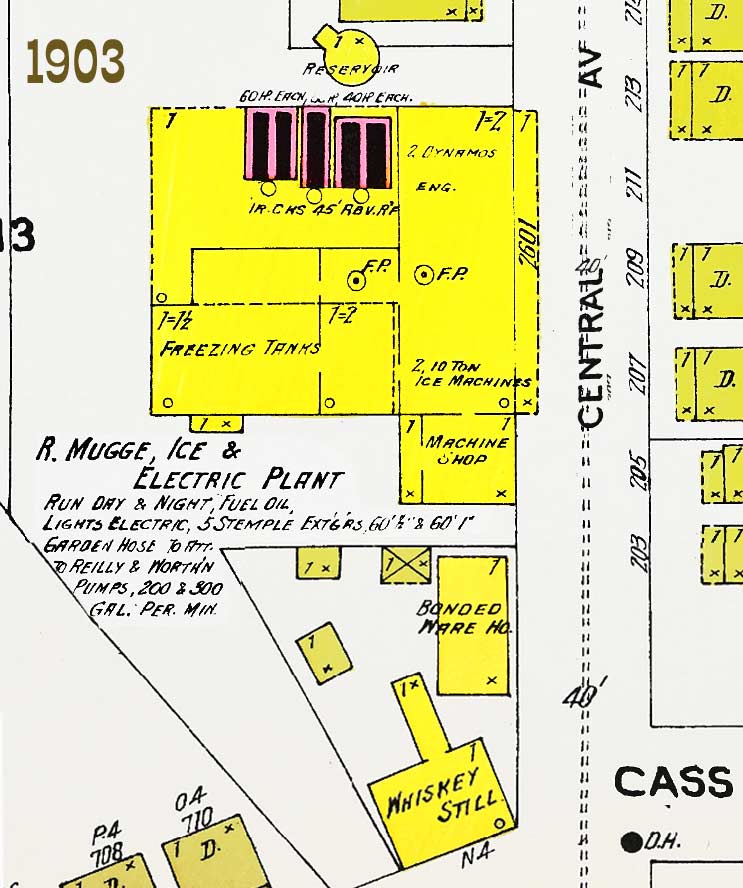



 The
photo below, taken from 15th Street and 7th Ave. in Ybor
City, looking northwesterly in 1899, shows the north side of
7th Avenue. The intersection was known as Robert Mugge
Corner because of one of Mugge's saloons located on the
corner. It can be seen at the far right, the 2-story wood
structure with the Anheuser-Busch Beer sign above the
awning. The 2-story wood structure (behind the horse
and buggy) is the location of Las Novedades Cafe.
The
photo below, taken from 15th Street and 7th Ave. in Ybor
City, looking northwesterly in 1899, shows the north side of
7th Avenue. The intersection was known as Robert Mugge
Corner because of one of Mugge's saloons located on the
corner. It can be seen at the far right, the 2-story wood
structure with the Anheuser-Busch Beer sign above the
awning. The 2-story wood structure (behind the horse
and buggy) is the location of Las Novedades Cafe.




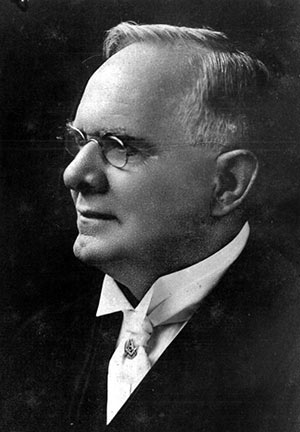














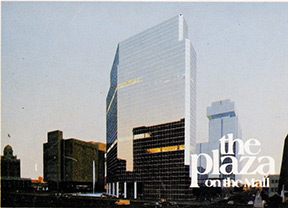




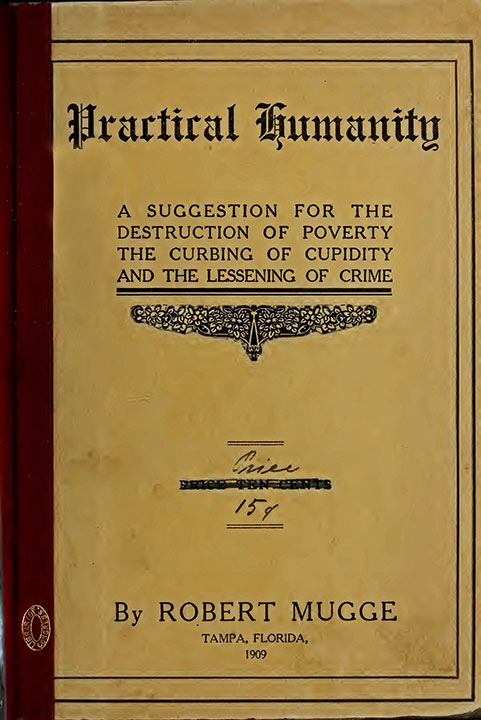




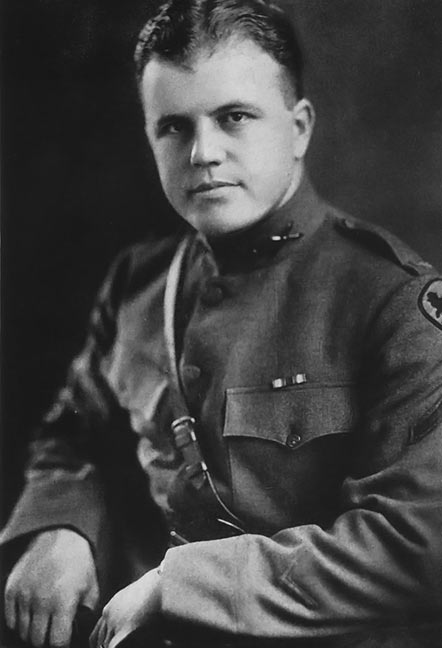



 At
the time the Bay View Hotel was completed, Robert Mugge installed
bowling alleys and pool tables on his property on Franklin Street. On a
Sunday morning in 1915, a photographer appeared and wished to take a
picture of the alleys. On the finished picture, in the left-hand corner,
appeared Robert Mugge reading the newspaper. This being the only picture
of Mr. Mugge known to be in existence, the photographer enlarged the picture and
shaded in the background dark. A few years following Mr. Mugge’s death,
his son August Mugge observed some paintings of former Tampa mayors on
the walls of various council chambers. He secured the name of the artist
from former Mayor D.B. McKay. A German artist, Wilhelm Teschner,
was given permission to paint, in oil, this enlarged picture at a cost
of $25. The artist had received small advances on the promised $25 and
when the picture was finished the family was so well pleased they gave
him an additional $75. A few months later the artist’s body was found in
an attic in Ybor City, with a brush and palette in his hands. He must
have died of a heart attack. Since the artist had no relatives, the City
of Tampa provided a lot in Woodlawn Cemetery and friends donated money
to pay for funeral expenses. A Methodist minister officiated.
At
the time the Bay View Hotel was completed, Robert Mugge installed
bowling alleys and pool tables on his property on Franklin Street. On a
Sunday morning in 1915, a photographer appeared and wished to take a
picture of the alleys. On the finished picture, in the left-hand corner,
appeared Robert Mugge reading the newspaper. This being the only picture
of Mr. Mugge known to be in existence, the photographer enlarged the picture and
shaded in the background dark. A few years following Mr. Mugge’s death,
his son August Mugge observed some paintings of former Tampa mayors on
the walls of various council chambers. He secured the name of the artist
from former Mayor D.B. McKay. A German artist, Wilhelm Teschner,
was given permission to paint, in oil, this enlarged picture at a cost
of $25. The artist had received small advances on the promised $25 and
when the picture was finished the family was so well pleased they gave
him an additional $75. A few months later the artist’s body was found in
an attic in Ybor City, with a brush and palette in his hands. He must
have died of a heart attack. Since the artist had no relatives, the City
of Tampa provided a lot in Woodlawn Cemetery and friends donated money
to pay for funeral expenses. A Methodist minister officiated.

 This
photo was taken in
1899. It shows "Robert Mugge Corner" in
Ybor City.
This
photo was taken in
1899. It shows "Robert Mugge Corner" in
Ybor City. 
